JULY-AUGUST 2023

CLEARED FOR TAKE-OFF CABIN CLIMATE A FRESH OUTLOOK PLUS

An exclusive interview with Emirates’ Adnan Kazim
The effects of humidity and temperature on-board
Azerbaijan is increasingly favoured by GCC visitors
businesstraveller.com
Lifestyle • Air Miles • Opinion • Tried & Tested
AIRSIDE
Navig ating t he r isingfortunesofcommercialaviation
FLIGHT PATH
















































































































































































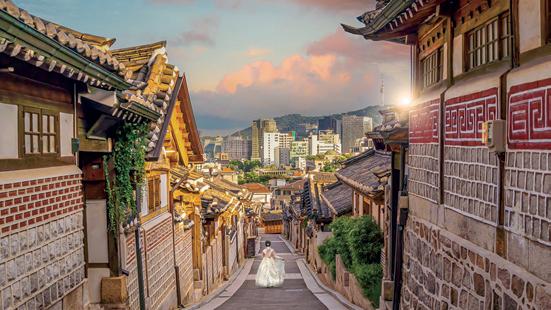





36 OPINIONS







Who should run airport lounges; Sixthfreedom carriers; Airlines and hotel investments: A marriage made in heaven?



52 LIFESTYLE
From city breaks to far- ung destinations, all the travel accessories you’ll need to pack
66 POSTCARD
Space ight company, Zephalto, opens bookings for ights starting 2024


16 CLEARED FOR TAKE-OFF Adnan Kazim, CCO for Emirates Airline, is overseeing one of the most pro table periods in the carrier’s history

26 HOT SPOT FOR CHANGE Dubai is leading the charge when it comes to sustainable innovation and growth




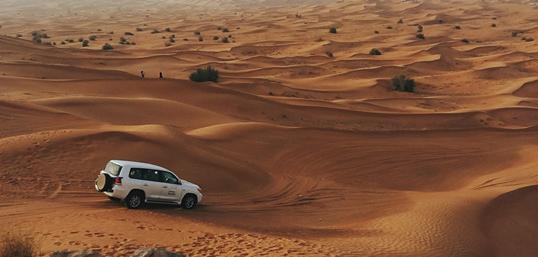

40 CABIN CLIMATE ermal comfort and humidity are set to become the next step change in cabin improvements

46 A FRESH OUTLOOK


A closer look at Azerbaijan’s appeal and its myriad o erings in Baku and beyond
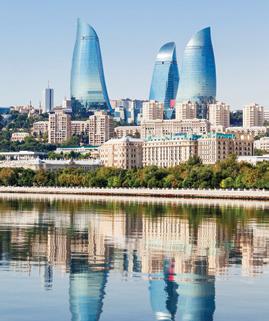
CONTENTS JULY-AUGUST 2023
REPORT TRIE D & TESTED HOTELS 60 Virg in Hotels New York 61 Marriott Resort Palm Jumeirah, Dubai 62 Shilla Stay Gwanghwamun, Seoul 63 Vinpearl Landmark 81Autograph Collection, Ho Chi Minh City 64 e Ritz-Carlton, Baku 64 61 JULY-AUGUST 2023 AZERBAIJAN TOURISM BOARD REGULARS FEATURES 16 26 40 06 UPFRONT e latest airline, hotel and travel news 12 SUSTAINABLE TRAVELLER Best practices from across the region 14 GLOBAL NEWS An update on international travel 32 AIR MILES Hisato Hamada, the chef-founder of Tokyo-based WAGYUMAFIA, opens his latest outpost in Saudi Arabia 34 HOTEL VIEWS Christian Hirt, managing director for Ra es and Fairmont hotels at the Katara Towers in Doha
THE
How the Middle East’s airline sector is moving the needle for the global aviation industry
46
COVER:
3
THRUST
CLARKWIN CRUZ
The question is not if, but how many times this year alone have you stepped onto an aircra ? A er all, the International Air Transport Association (IATA) recently said that it expects 4.35 billion people to y in 2023. at’s a staggering gure given that a little over a year-and-a-half ago, the bruised-and-battered aviation sector was hobbling its way to the semblance of a recovery.
Here in the Middle East, a hub for global air travel, that resurgence has been abundantly evident. Whether its Dubai International airport welcoming more than 66 million passengers in 2022 earning itself the accolade of the world’s busiest international airport for the ninth year in a row, or Saudi Arabia bracing itself for an anticipated surge in visitors and announcing new airports and airlines, turn to our cover story (pg 20) for a deep-dive into the growth of commercial aviation in this region and nd out what lies ahead for it. ere are plenty more aviation pieces within the following pages. Explore the e ects of temperature and humidity on aircra cabins (pg40). Fun fact: did you know that the average humidity level in business class
THIS ISSUE’S PICKS

cabins on long-haul ights is around 7 per cent, while in a cockpit it’s less than 2.5 per cent? Our Opinion pieces also deliver fascinating insights from whether hoteliers or caterers are better suited at running airport lounges (pg36), to what exactly is sixth-freedom tra c (pg38) and an inspection of the phenomena of some airlines becoming hotel owners (pg39).
Also in this edition, we feature Azerbaijan (pg46) which secured 1.6 million foreign visitors last year and hopes to increase that to four million by 2026, helped along by an increasing number of visitors from the GCC. Our Tried & Tested section, meanwhile, has several hotel reviews in key cities including Ho Chi Minh City, New York City, Seoul, Baku and right here in Business Traveller Middle East’s home turf of Dubai. is is a combined summer edition for the months of July and August, and as we take some time to unwind away from the workplace, we hope you can do the same. We’ll see you in September – refreshed, ready and rearing to take on the last quarter of this year.
Enjoy your summer travels, enjoy the issue.
Business Traveller Middle East is jointly published by Motivate Media Group and Panacea Media Ltd
MOTIVATE MEDIA GROUP
Editor-in-Chief Obaid Humaid Al Tayer
Managing Partner and Group Editor Ian Fairservice
Editor Varun Godinho
Art Director Clarkwin Cruz

Editorial Co-ordinator Londresa Flores
Contributors Tamsin Cocks, Hannah Brandler, Melanie Swan, Camille Macawili, Amy Sessions, Joseph Phelan, Updesh Kapur, Akanksha Maker
General Manager – Production S Sunil Kumar


Production Manager Binu Purandaran
Production Supervisor Venita Pinto
Chief Commercial Officer Anthony Milne
Group Sales Manager Chaitali Khimji
Senior Sales Manager Murali Narayanan
PANACEA MEDIA LTD
Managing Director Julian Gregory
Associate Publisher Middle East Rania Apthorpe

businesstraveller.com

CLEARED FOR TAKE-OFF
Adnan Kazim, CCO of Emirates Airline (Page 16)

HOT SPOT FOR CHANGE
Dubai’s push towards a sustainable future (Page 26)

HEAD OFFICE:Media One Tower, Dubai Media City, PO Box 2331, Dubai, UAE.
Tel: +971 4 427 3000; Fax: +971 4 428 2266, E-mail: btme@motivate.ae
DUBAI MEDIA CITY: SD 2-94, 2nd Floor, Building 2, Dubai, UAE.
Tel: +971 4 390 3550; Fax +971 4 390 4845
AIR MILES
Hisato Hamada, the chef-founder of WAGYUMAFIA (Page 32)



ABU DHABI: PO Box 43072, Abu Dhabi, UAE. Tel: +971 2 677 2005; Fax: +971 2 657 3401, Email: motivate-adh@motivate.ae
SAUDI ARABIA: Office 452, Regus Offices, 4th Floor, Al Hamad Tower, King Fahad Road, Al Olaya, Riyadh, KSA
Tel: +966 11 834 3595 / +966 11 834 3596; Fax: +966 11 834 3501; Email: motivate@motivate.ae
LONDON: Motivate Publishing Ltd, Acre House, 11/15 William Road, London, NW1 3ER, UK
E-mail: motivateuk@motivate.ae
Panacea Media Ltd
41-43 Maddox Street, London, W1S 2PD
Tel +44 (0)20 7821 2700 businesstraveller.com
Panacea Publishing Asia Ltd




#2408 24/F Dominion Centre, 43-59 Queen’s Road East, Wanchai, Hong Kong, Tel: +852 2594 9300, Fax: +852 25196846
SUBSCRIPTIONS: email subscriptions@motivate.ae; tel +971 4 427 3542
WELCOME JULY-AUGUST 2023 © 2023 PANACEA MEDIA LTD AND MOTIVATE MEDIA GROUP
4
Varun Godinho, Editor

Playcation ULTIMATE SUMMER Experience the ultimate summer escape at Hilton Abu Dhabi Yas Island. Pick your playcation from relaxation, indulgence, or thrilling adventure. Kids stay free. Yas Theme Park access including SeaWorld® Yas Island Abu Dhabi included in every stay. It matters where you stay. BOOK NOW AT HILTON.COM T. +971 2 208 6888 | E. Reservations.YasIsland@Hilton.com
US, UK





and

Schengen visa holders now eligible for instant Saudi e-visas


IN JUNE, SAUDI ARABIA added six additional categories of individuals eligible for instant e-visas to visit the country. Now, UK, US, and Schengen visa holders, as well as permanent residents of the UK, US, and any EU country can obtain e-visas via the government’s o cial website (mofa. gov.sa). ese visas can be obtained for several purposes including tourism, attending events, conferences and exhibitions as well as for performing Umrah throughout the year, except during the
Riyadh Air showcases livery, conducts low-altitude flight over Saudi capital











Rotana to open 600-key property in Georgia

ABU DHABI-HEADQUARTERED hotel management company Rotana has signed an agreement with Pontus Development to open a new 600-key property in Georgia. Pontus Rotana Resort and Spa Gonio will be located in a beach suburb of Batumi, and is scheduled to welcome its first guests by 2026. The five-star resort will o er several services and amenities including a private beach, several dining venues, a spa, indoor and outdoor swimming pools, and a fitness centre. Rotana currently operates 73 hotels in the Middle East, Africa, Eastern Europe and Türkiye, hosting more than six million guests per year.





IN JUNE, the Public Investment Fund-owned Riyadh Air unveiled its signature indigo livery. Ahead of the commencement of its operations in 2025, and having received its “RX” airline designator code from the International Air Transport Association, a Boeing 787-9 Dreamliner in the carrier’s livery conducted a low-altitude flight over the Saudi capital. The airline has placed an order for up to 72 Boeing 787-9 Dreamliner aircraft, including 39 confirmed orders and an option to acquire 33 additional widebody aircraft. The airline said that it aims to connect to more than 100 destinations around the world once it commences operations.
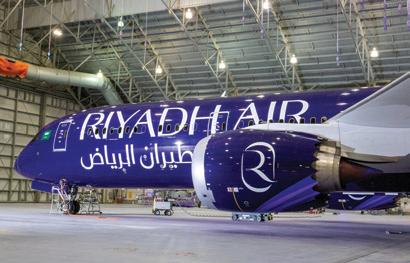
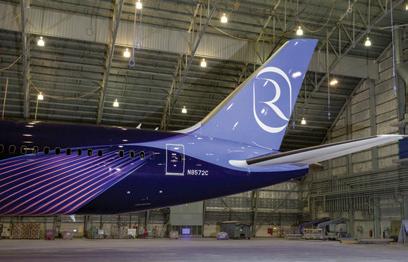
6 UPFRONT JULY-AUGUST 2023
Marriott Executive Apartments enters Kuwait

MARRIOTT EXECUTIVE APARTMENTS has debuted in Kuwait with the opening of Marriott Executive Apartments Kuwait City. Owned by Assima Real Estate Company, the property features 164 residential apartments. It includes studio, one-, two- and threebedroom apartments with views of the city’s skyline. Each apartment o ers fully-equipped kitchen facilities, with items delivered to the doorstep by the hotel’s on-demand grocery shopping service. Marriott says that the hotel is the first luxury serviced apartment brand of its kind in the country and is one of three hotel brands in Kuwait owned by Assima Real Estate Company in partnership with Marriott International.
TURKISH AIRLINES AGREES CODESHARE WITH THREE AIRLINES

IN JUNE, TURKISH AIRLINES (TK) which celebrates its 90th anniversary this year, signed codeshare agreements with three major airlines including ITA Airways, Vietnam Airlines and Icelandair. ITA’s ight numbers will be placed on TK ights between Rome and Istanbul. Reciprocally, TK will place its ight numbers on nine destinations of ITA within Italy from Rome. Meanwhile, TK will also use its code on Vietnam Airlines-operated ights between Hanoi-Da Nang and Ho Chi Minh City-Da Nang. Likewise, Vietnam Airlines will place its code on TK’s Istanbul-Hanoi and Istanbul-Ho Chi Minh routes. e latest codeshare also allows Icelandair passengers in North America and Iceland to connect via Turkish Airlines’ network to Istanbul. Also, TK passengers from around the world can connect via Icelandair’s network to Iceland and Canada.
VIRGIN ATLANTIC ANNOUNCES SEASONAL SERVICE TO DUBAI
VIRGIN ATLANTIC will resume flights to Dubai this year with a four-times-weekly seasonal service. The services will operate from October 28, 2023, through to March 2024, using its Boeing 787-9 aircraft. The airline, which last operated flights to Dubai in March 2019, said that it expects the route to “be a hit with leisure customers” and aims to “capture the increased demand for premium winter sun getaways”. The carrier’s Dubai-London flight will also connect with Virgin/Delta onward flights to North American locations including New York, Seattle, San Francisco and Los Angeles.

7 JULY-AUGUST 2023
Hyatt to triple Saudi portfolio in five years
HYATT INTENDS to triple its portfolio within Saudi Arabia over the next five years. Major upcoming projects include the debut of properties such as Miraval The Red Sea, as well as its entry into Madinah following the three signings for a combined 1,729 keys earlier this year. Its plans involve opening Grand Hyatt Madinah, Hyatt Regency Madinah and Hyatt Place Madinah in the city.
Hyatt also shared its Q1 2023 performance which indicated a 256 per cent year-on-year growth in revenue across managed and franchised hotels in Europe, the Middle East and Africa (EMEA). As of the first quarter of 2023, the EMEA region represented 10 per cent of Hyatt’s global pipeline. Within the Middle East, Hyatt expects to debut two lifestyle brands in Qatar over the next 12 months with the openings of Andaz Doha and Dream Doha, which together will grow its footprint in Qatar’s capital by 50 per cent.

Air Baltic to commence Dubai-Vilnius ights this November


THE FLAG CARRIER of Latvia, Air Baltic, has opened booking for flights between the capital of Lithuania, Vilnius, and Dubai. It follows approvals granted by the Lithuanian government to do so. Flights from Vilnius to Dubai will commence on November 1 as part of the airline’s winter season schedule. It will be operated twice a week on Wednesdays and Saturdays and will complement the already existing all-year-round route between Riga and Dubai.
CONRAD DUBAI INTRODUCES RESIDENTIAL SUITES
CONRAD DUBAI has launched a collection of 22 one-bedroom residential apartment suites within its property located on Sheikh Zayed Road. Spread over an area of 100 sqm, each residence has a master bedroom with marbled-clad bathrooms stocked with luxury hotel amenities and featuring separate baths and rain showers. Two-bedroom suites are also available as connecting rooms. Residential suite guests will have their apartments serviced by the hotel itself and have access to the property’s 24-hour reception to attend to any requests. For an additional monthly fee, residential suite guests can also access the Executive Club lounge.

8
JULY-AUGUST 2023
UPFRONT
Flynas orders 30 additional A320 neo jets


AT THE PARIS AIRSHOW held in June, Saudi low-cost carrier flynas confirmed an order with Airbus for 30 new A320 neo aircraft in a deal valued at SAR14 billion at the current list prices. It takes the airline's total order with Airbus up to 120 A320 neo aircraft. Flynas is an all-Airbus operator and was the first carrier in the kingdom to acquire an A320 neo. It has increased its fleet size by 94 per cent to 49 aircraft in the last 24 months alone. The airline currently flies to 70 domestic and international destinations and plans to eventually ramp that number up to 165 points.
EMIRATES PREMIUM ECONOMY TO ROLL OUT ON MUMBAI, BENGALURU ROUTES
EMIRATES WILL SOON introduce its premium economy seats on two routes to India. Starting October 29, the carrier’s newly-retro tted A380 aircra with these seats will operate via a daily nonstop service to both Mumbai and Bengaluru. e airline introduced its superjumbo on the Dubai-Mumbai route back in 2014 and to Bengaluru in October last year. In addition to the premium economy seats, the retro tted aircra feature enhanced upgrades and refreshed interiors across all its other cabin classes too. Premium economy seats will also debut on routes to Los Angeles in July, taking the number of routes o ering the product to 12 by the end of this year.

Six Senses con rms upcoming property in Amaala

SIX SENSES has said that it will open a new property in the Amaala development located in the northwest of Saudi Arabia. Six Senses Amaala will feature 64 rooms, six suites, 30 villas, and 25 branded residences designed by architects U+A, with interiors by Studio Carter. The property will be located along Amaala’s Triple Bay area, and will o er panoramic views across the Hijaz Cove to the Red Sea. With a large focus on wellness, its spa facilities will include a cryotherapy chamber, longevity clinic, male and female thermal areas featuring Finnish and infrared saunas, salt rooms, herbal steam rooms, ice baths and vitality pools.

9 JULY-AUGUST 2023
NEOM TO GET 270-KEY ANANTARA RESORT
MINOR HOTELS will open an Anantarabranded property in the upcoming Trojena development in Saudi Arabia, the year-round mountain destination which is a part of NEOM.
The 270-key Anantara resort will include a mix of rooms and suites, some with private pools, with each of them
o ering either lake or mountain views. The Anantara resort will be located in the Water Village, part of the Valley Cluster of Trojena, which will feature a 2.8km long man-made fresh-water lake.

Last year, Ennismore was the first hospitality company to declare plans to open in Trojena. It will be bringing its
Air Astana to initiate new flight to Tel Aviv
AIR ASTANA has begun selling tickets for its new direct flight from Kazakhstan’s capital of Almaty to Tel Aviv. The twice-weekly flights will be operated on Thursdays and Sundays using the airline’s Airbus A321 neo long-range aircraft starting September 7.

This service represents the first direct air service between Kazakhstan and Israel. The duration of the flights will be 6 hours 45 minutes outbound, and 5 hours 50 minutes inbound to Almaty, with the aircraft featuring 16 lie-flat business class seats and 150 economy seats.
25 Hours Hotels and Morgans Originals brands to Trojena. Subsequently, General Hotel Management also signed an agreement to open Chedi Trojena, and Collective Retreats said that it too would open a sustainability-focused property in Trojena by 2026 called Collective Trojena.
SalamAir to lease three A330 neo aircraft
OMANI CARRIER SalamAir has said that it will lease three A330 neo aircra from Avolon, an international aircra leasing company. ese will be its rst widebody aircra and SalamAir says it will operate them on longer routes to Asia Paci c and European destinations. e rst deliveries of the aircra to the Muscat-based airline will commence in October this year. e incoming A330 neo aircra will feature a dual-class con guration with 365 economy seats and 12 premium atbed seats. As it grows its destination network, this July, the airline will launch ights to Kuala Lumpur and Almaty.

10 UPFRONT JULY-AUGUST 2023














































































































Qatar Airways signs deal for SAF purchase at Schiphol airport



In a multi-million dollar deal, Qatar Airways has agreed with Shell to obtain 3,000 metric tonnes of neat sustainable aviation fuel (SAF) at Amsterdam Schiphol airport. e airline said that of its entire jet fuel requirement in Amsterdam over the scal year of 2023-2024, at least 5 per cent will be a SAF blend. e airline said that it expects to reduce its emissions on ights from Amsterdam by approximately 7,500 tonnes of carbon dioxide for the scal year by way of this agreement. “We remain steadfast in our ambitious target of 10 per cent SAF use by 2030 and this announcement establishes another landmark for Qatar Airways that underlines the positive outcome of the industry’s collaboration which is critical to accelerating the SAF supply and achieving our target. SAF is still three to ve times more expensive than fossilbased jet fuel. is is why it is essential for all stakeholders to play their part in facilitating research and development of SAF facilities, enhancing economies of scale, providing nancing and placing supportive policies,” said Akbar Al Baker, the group chief executive of Qatar Airways.
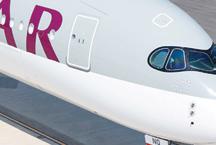




ASCOTT TO REDUCE CARBON EMISSIONS ACROSS PROPERTIES




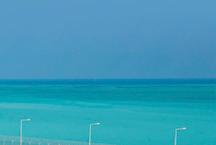
AS PART OF ITS sustainability practices, Ascott has pledged to reduce its carbon emissions intensity by 78 per cent worldwide, decrease its water consumption intensity by 45 per cent and energy consumption intensity by 35 per cent, and achieve a 25 per cent increase in recycling processes for its daily operations –compared to a 2008 baseline – by 2030. Ascott said that it would also improve its waste management as well as its supply chain processes through environment, health and safety (EHS) systems, which in turn will reduce energy consumption across its properties globally. Regionally, Ascott will introduce initiatives such as using plant-based cutlery within its properties too.
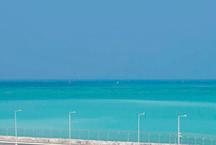
JULY-AUGUST 2023
12 SUSTAINABLE TRAVELLER
Last year, the global community began negotiating a legally binding agreement to end plastic pollution. This is a promising rst step, but we need all hands-on deck. A new report by the UN Environment Programme shows that we can reduce plastic pollution by 80 per cent by 2040 – if we act now to reuse, recycle, reorient, and diversify away from plastics” -- UN Secretary-General Antonio Guterres on World Environment Day 2023
QUOTE OF THE MONTH
MILLENNIUM HOTELS PARTNERS WITH WATERMELON ON UAE FOOD SUSTAINABILITY INITIATIVE

MILLENNIUM HOTELS AND RESORTS has partnered with Watermelon, a food and beverage procurement platform, to incorporate locally sourced produce across its hotels within the UAE. Millennium says that the partnership aims to “revolutionise the way food is sourced, delivered, and consumed across its hotels in the UAE.”
Watermelon’s team sources and partners with local farmers and fishermen in the UAE to o er a selection of fresh fruits, seafood and vegetables through its platform. As part of the initiative, the executive chef at Millennium Plaza Downtown, Christophe Prud’homme, will prepare an exclusive menu using locally-sourced produce at the hotel’s Italian restaurant, Al Fresco. Plans are also afoot to launch a “Home Farm” style breakfast featuring produce sourced from UAE farms.
This year’s theme for World Environment Day held in June was ‘Beat Plastic Pollution’. Here are some eye-opening figures from the United Nations:
400
19-23
50,000
EMIRATES UNVEILS CLOSED LOOP RECYCLING PROGRAMME
STARTING IN JUNE, Emirates initiated a new closed loop recycling programme on-board its aircra . By way of this initiative, the airline said that millions of on-board items including plastic trays and casserole dishes will now be recycled in a local facility and repurposed into products which can be reused for the Emirates meal service.
Old and damaged meal service items from its economy and premium economy class will be collected a er ights and transported to a facility in Dubai to be ground down, reprocessed, and manufactured into new dining products including dishes, bowls and trays. ose products will then be sent to Emirates Flight Catering to be redeployed on Emirates’ aircra worldwide.
Emirates has partnered with deSter FZE UAE for this initiative. e new trays, casseroles, snack dishes and bowls, would potentially contain around 25 per cent reused material.

Emirates says that it diverts more than 150 million single-use plastic items from land lls each year by replacing items such as plastic straws, stirrers and in ight retail bags with paper and wooden alternatives.
Korean Air upcycles retired Boeing 777 fuselage skin
KOREAN AIR has released upcycled name tags and golf ball markers made from one of its retired Boeing 777-200ER aircraft. The limited-edition products are made using the skin of a dismantled aircraft which had a registration number of HL7715. Made from the surface of the fuselage, each product is numbered and engraved with the words “Boeing 777200ER” and “HL7715”. There are only 5,000 name tags and 2,000 golf ball markers available for purchase on the airline’s e-skyshop. HL7715 operated 11,274 flights to 95 cities, before being retired in March 2020.

JULY-AUGUST 2023
MILLION TONNES The amount of plastic produced annually worldwide
TONNES
MILLION
The quantity of plastic that ends up in rivers, lakes and seas annually
13
The estimated quantity of plastic particles consumed annually by each person on the planet
Nobu to open hotels in New York and Bangkok
Nobu Hospitality has signed an agreement with Thai real estate group, Asset World Corp Public Company, to open hotels in Bangkok and New York. The Hotel Plaza Athenee New York will reopen in 2026 as the Plaza Athenee Nobu Hotel and Spa New York, while the Plaza Athenee Nobu Hotel and Spa Bangkok will also open in 2026.

Second Anantara announced for Brazil





Minor Hotels will open Anantara Preá Ceará Resort along Brazil’s northeast coast by 2026. It will feature 60 guest rooms and villas, 25 branded residential bungalows as well as a 120 sqm Presidential suite. The Anantara Mamucabo Bahia Resort, scheduled to open in 2025, will be the first Anantara to open in Brazil as well as in South America.

Wizz Air inaugurates new European routes to Egypt


Wizz Air has inaugurated two new routes between Italy and Egypt. The airline now flies from the Italian cities of Milan and Rome to Sphinx International airport in Cairo. It has also announced new routes from Budapest to Sphinx International and from Milan to Hurghada. The carrier currently operates 22 routes to Egypt.
Tashkent gets new InterContinental InterContinental Hotels and Resorts has opened the InterContinental Tashkent, its first property in the Uzbek capital. Part of the new Trilliant Business Park development, it features 216 rooms, including 38 signature suites and two presidential suites. Located in the heart of the capital, it is a fiveminute walk from Amir Temur Square.
IndiGo places record order for 500 A320 aircraft
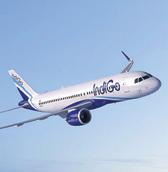

IndiGo placed an order for 500 Airbus A320 aircraft at the Paris Air Show, with deliveries expected between 2030 and 2035. It is the biggest single purchase agreement in commercial aviation and takes Indigo’s order book to 1,330 Airbus aircraft. The Indian carrier is now the world’s biggest A320 Family customer.

14 UPFRONT GLOBAL NEWS JULY-AUGUST 2023 1 2
SIA resumes fourth daily flight to Hong Kong
From July 1, Singapore Airlines resumed its fourth daily service between its home base and Hong Kong. The SQ894 flight is operated using a four-class Boeing 777300ER, which includes four open first class suites and 28 premium economy recliners. Pre-pandemic, the airline would conduct up to six flights daily on this route.






IHG’s voco enters Vietnam









IHG Hotels and Resorts has opened voco Ma Belle Danang, the first voco in Vietnam. Danang is among the largest cities in Vietnam. The hotel features three restaurants, and more than 520 sqm of meetings and events spaces. The 27-storey hotel is also voco’s 50th opening globally. Voco aims to open 200 properties worldwide by 2028.
Ritz-Carlton Reserve opens in China


Rissai Valley, a RitzCarlton Reserve, was recently unveiled in Jiuzhaigou, a valley in China’s Sichuan province. The property’s 87 villas o er stunning views of the Minshan mountain range. Located on the edges of the Qinghai-Tibet plateau, the region has been designated by UNESCO as a World Heritage Site.
Air Niugini orders 787 Dreamliners


Papua New Guinea flag carrier, Air Niugini, has placed an order with Boeing for two 787-8 Dreamliners. Air Niugini currently flies 767-300ERs and a single 737-800, to several destinations including Sydney, Melbourne, Hong Kong, Singapore and Tokyo. The carrier had previously signed an order with Boeing for four 737 Max aircraft.

Hyatt to debut in Australia



The first Caption by Hyatt hotel in Australia will open in Sydney by early 2025. Located in Haymarket, a vibrant multicultural neighbourhood at the southern end of the Sydney Central Business District, construction has already begun on the 174-key hotel. The first Caption by Hyatt property debuted in Tennessee in 2022.

15 JULY-AUGUST 2023 7 3 9 8 4 10 5
Caption by
6
Cleared for take-off

WORDS VARUN GODINHO
 Adnan Kazim , chief commercial officer for Emirates Airline, is overseeing one of the most remarkable and profitable periods in the carrier’s history. Here’s how he plans to keep up the momentum
Adnan Kazim , chief commercial officer for Emirates Airline, is overseeing one of the most remarkable and profitable periods in the carrier’s history. Here’s how he plans to keep up the momentum
To swing from a US$1.1 billion loss, to a US$2.9 billion profit in a span of 12 months is no trivial feat. When Emirates posted its annual profit for the financial year of 20222023 ending March 31, 2023, it noted that revenue too was up 81 per cent to US$29.3 billion, thereby indicating the full scale of the recovery it had made from the pandemic-induced losses it incurred the year prior. This, mind you, was achieved in the midst of consistently high oil prices, soaring inflation rates globally that squeezed recreational travel, and a conflict in East Europe that has impacted travel corridors between Europe and Asia.


Still, the airline carried 43.6 million passengers through the 2022-2023 period, a 123 per cent increase year-on-year. Its seat capacity was also up 78 per cent. “From a demand perspective, we’re exceeding pre-Covid levels,” Emirates Airline’s chief commercial officer, Adnan Kazim, told Business Traveller in an exclusive interview along the sidelines of the recently concluded Arabian Travel Market. Kazim said that the momentum for the airline began with last year’s summer season and sustained right through February which is generally considered the low season for travel. “To reflect that, we ramped up the capacity to 80 per
cent by the end of the financial year in March this year, and we’re moving towards 90 per cent by this summer, before ending this financial year at 95 per cent. By the start of the next financial year, we should be reaching the 100 per cent mark,” says Kazim. The airline is currently flying to approximately 140 destinations. One of the major markets that it is poised to focus on in the coming years,
he says, is North America. To that end, Emirates recently activated its codeshare with United. Emirates flies to three hubs in the US – Chicago, Houston and San Francisco. By way of the codeshare, Emirates passengers can access more than 150 US cities in the United network via those three gateways. Due to an interline agreement between the two carriers, Emirates passengers can also choose from dozens of more destinations outside of the US in Canada, Mexico, the Caribbean, and Central and South America via the three hubs. Towards the end of last year, Emirates also activated a codeshare with Canada’s largest carrier, Air Canada, to provide customers access to 46 points across the North American, Asian, Middle Eastern and African markets. Emirates customers can therefore book codeshare flights to and from Canadian points beyond Toronto, including Montreal, Calgary, Edmonton, Vancouver, Halifax and Ottawa.
“We have a solid partnership with United and Air Canada, two giant companies that have massive networks in the US and Canada. It opens new opportunities to enter many markets that were not feasible for us to operate. With Air Canada by our side, we have managed to add Montreal to our operations because Montreal is a hub for Air Canada from where 40 per cent of its capacity and deployment of flights takes place. Likewise, Air Canada is coming in from Vancouver to Dubai with the full cooperation of Emirates,” says Kazim in reference to the announcement that Air Canada made regarding its four times weekly nonstop flights between YVR and DXB which will commence in October.
“As for United, we already launched a codeshare for 150 destinations and that number will ramp up to about more than 400 interline and codeshare destinations in the future. Our upcoming A350 aircraft with a 300-seater capacity and a range of up to 15 hours will be ideal for expansion into the Americas.”
17
JULY-AUGUST 2023
EMIRATES
ABOVE: Adnan Kazim
BELOW: Emirates at the Arabian Travel Market in Dubai
OPPISITE PAGE: Emirates recently showcased its new signature livery
The aim is to get the premium economy into 65 per cent of our network
A SPRAWLING NETWORK
As of the end of March this year, Emirates had a fleet of 260 aircraft. It currently has orders for 50 Airbus A350s, 117 Boeing 777Xs and 30 Boeing 787-9s. At a roundtable at the 79th annual general meeting of the International Air Transport Association in Istanbul in June, Emirates’ president, Tim Clark, indicated that the airline might order additional A350s, Boeing 777-9s or even Boeing 787s, without confirming a timeframe or size of that potential order.
For now, the superjumbo A380 remains its flagship aircraft. The first
EMIRATES

BELOW FROM TOP: Penelope Cruz is the new brand ambassador for Emirates; The carrier's first class lounge at DXB; The airline higlights its commitment to sustainability

OPPISITE PAGE FROM TOP: The airline will deploy 90 A380s by the end of summer this year; Emirates won four accolades at the Business Traveller Middle East Awards 2023
Emirates A380 entered into service in 2008, while the final one – its 123rd – was delivered in December 2021. With demand creeping up, Emirates is rolling out that aircraft onto a greater number of routes. “We have 85 A380s operating today, and that number will jump up to 90 before the end of summer and to 95 by the end of the financial year. As far as the network deployment is concerned, the A380 has already been deployed to 43 points. This number will increase to 50 before the end of summer as we deploy it to Taipei, Bali, Shanghai, Beijing, Nice and Birmingham,” says Kazim.
Emirates is bullish about the prospects of two new additions to its fleet over the coming months by way of its Airbus A350 and Boeing 777x widebody long-range fuelefficient aircraft. “We have a lineup of aircraft that will start to come into the fleet in August 2024. We have an order for 50 A350s which will start entering the fleet in the next financial year, and the delivery of those will be completed over three-and-a-half years. Those 50 aircraft will be divided into two different sub-fleets. One is for regional operation within a range of seven-eight hours and can reach places in Africa, the Middle East, Europe and Asia. The second subfleet of the A350s will head towards destinations that are more than ten hours away from Dubai.
“The year after [the A350 begins to enter the Emirates fleet], we have the Boeing 777x entering in phases. Those aircraft will partly replace our older [Boeing 777] ER, but partly also add to our fleet expansion,” observes Kazim. He says that all of the airline’s Boeing 777 fleet – more than 130 of them – are currently deployed.
While aircraft acquisition is underway, Emirates has also embarked on a massive fleet retrofit project that will focus on around 120 of its existing aircraft including 67 A380s and 53 777s. The US$2 billion project that began towards the end of last year will be completed by 2025. The carrier has prioritised the

retrofitting of its earmarked A380s after which it will focus on its 777s. Overall, it includes refurbishing 728 first class suites, upgrading more than 5,000 business class seats and installing 4,000 of the airline’s new premium economy seats. On average, two-and-a-half aircraft are being retrofitted each month. Emirates’ determination to refresh the look and feel as well as the user experience on-board its aircraft has meant that it has also invested more than US$350 million on the in-flight experience in its upcoming A350 fleet by selecting the Thales’ AVANT Up system which features 4K QLED HDR displays, two Bluetooth connections and builtin wifi for passengers to pair multiple devices to it.
Perhaps the most significant change coming to the airline is the increasing presence of its premium economy class which it first showcased in 2022. The carrier began by fitting the premium economy into six A380 aircraft which it deployed to London, Paris and Sydney. “When we planned the premium economy, we had in mind flights that exceeded six hours

18
JULY-AUGUST 2023
so that we could get the full benefit from the economics of it and also that the consumer would get the full benefit from the comforts of it. Today, we have 12 aircraft with premium economy class and as the retrofit programme continues, we will have 17 more aircraft with premium economy seats by the end of this summer. Flights with the premium economy cabin are being operated to London, Sydney, Melbourne, Christchurch, Auckland, JFK, San Francisco, Singapore and Houston.
“One of the concerns we had at one stage with premium economy is that it might cannibalise traffic from business class. Instead, what we had was traffic from the economy class shifting towards premium economy. The aim is to get the premium economy into 65 per cent of our network,” reveals Kazim.
BROADENING HORIZONS
In January this year, Emirates reached a milestone when it conducted its first flight with 100 per cent sustainable aviation fuel (SAF) in one engine of a B777-300ER. While the results of

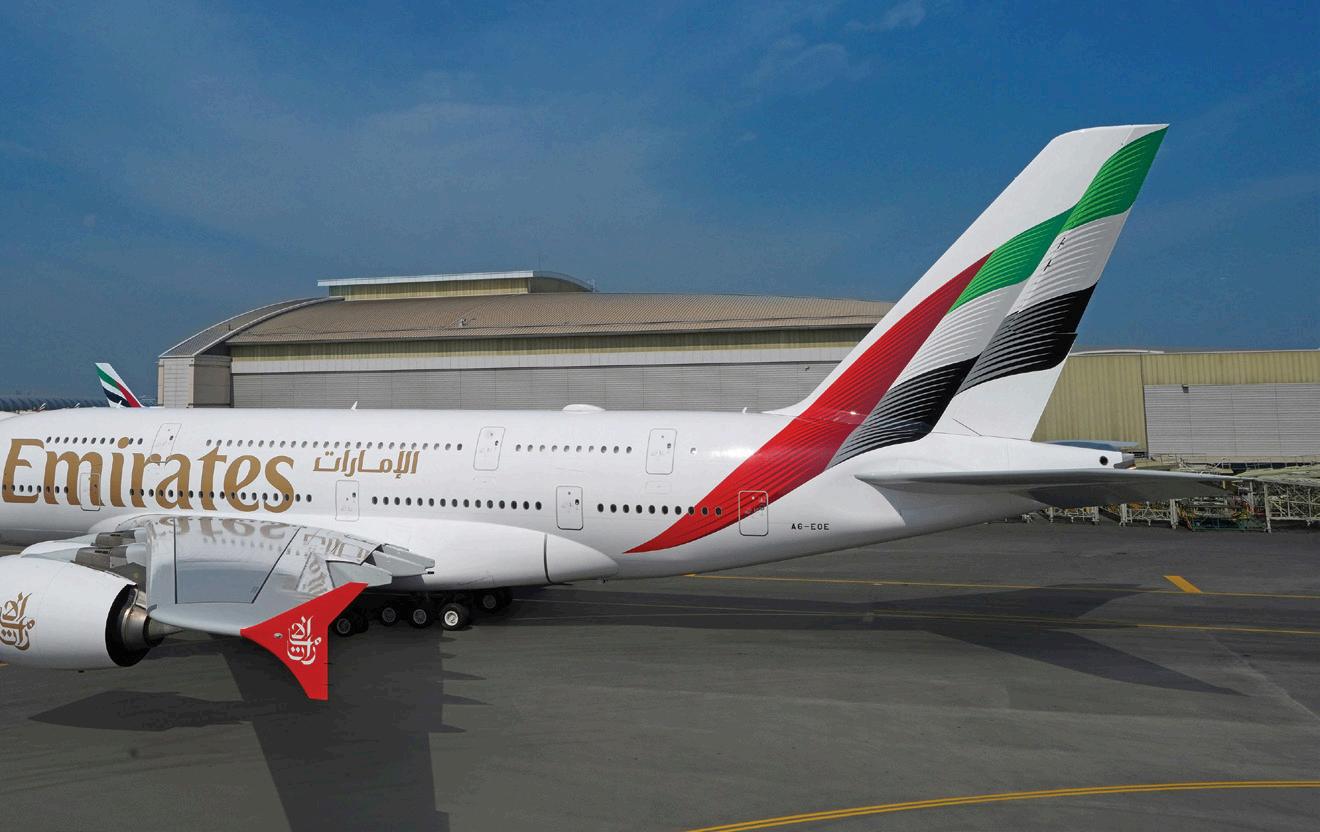
that flight are encouraging, Kazim cautions as to ongoing concerns with the availability of SAF and also the exorbitant price of it. It is currently nearly six-eight times more expensive than it should be for it to become a commercially viable option, he says. Consequently, in May, Emirates said it had committed US$200 million to fund R&D projects that seek to reduce the impact of fossil fuels in commercial aviation.
Apart from addressing the issue of sustainability, the airline – like its peers – is also facing challenges in other areas. Kazim references the situation in Ukraine, as well as the constant manoeuvrings around strikes called for in European cities and the occasional lack of skilled labour to support ground operations outside of Dubai.
“If tomorrow, for example, Emirates
wants to add frequencies and capacity in certain markets, it’s not as easy as it used to be. That’s because either the capacity of the airports have not fully resumed to 100 per cent or maybe even their ground handling departments don’t have efficient manpower to cope with the growth at that airport,” says Kazim while adding that it might take another two years for the situation overall to stabilize and adapt to the current scenario. Those challenges don’t seem to be weighing down the airline as it posted record profits earlier this year. “People are desperate to travel, they want to get to a different destination. That has helped the situation for us. We already increased our Available Seat Kilometres (ASKM) by 31 per cent just to meet this summer’s high demand,” notes Kazim. At this rate, come March next year, the figures that come out from the airline might reveal that its winning streak hasn’t let up after all.
19 JULY-AUGUST 2023
We have 85 A380s operating today, and that number will jump up to 95 by the end of the financial year
FULL THRUST
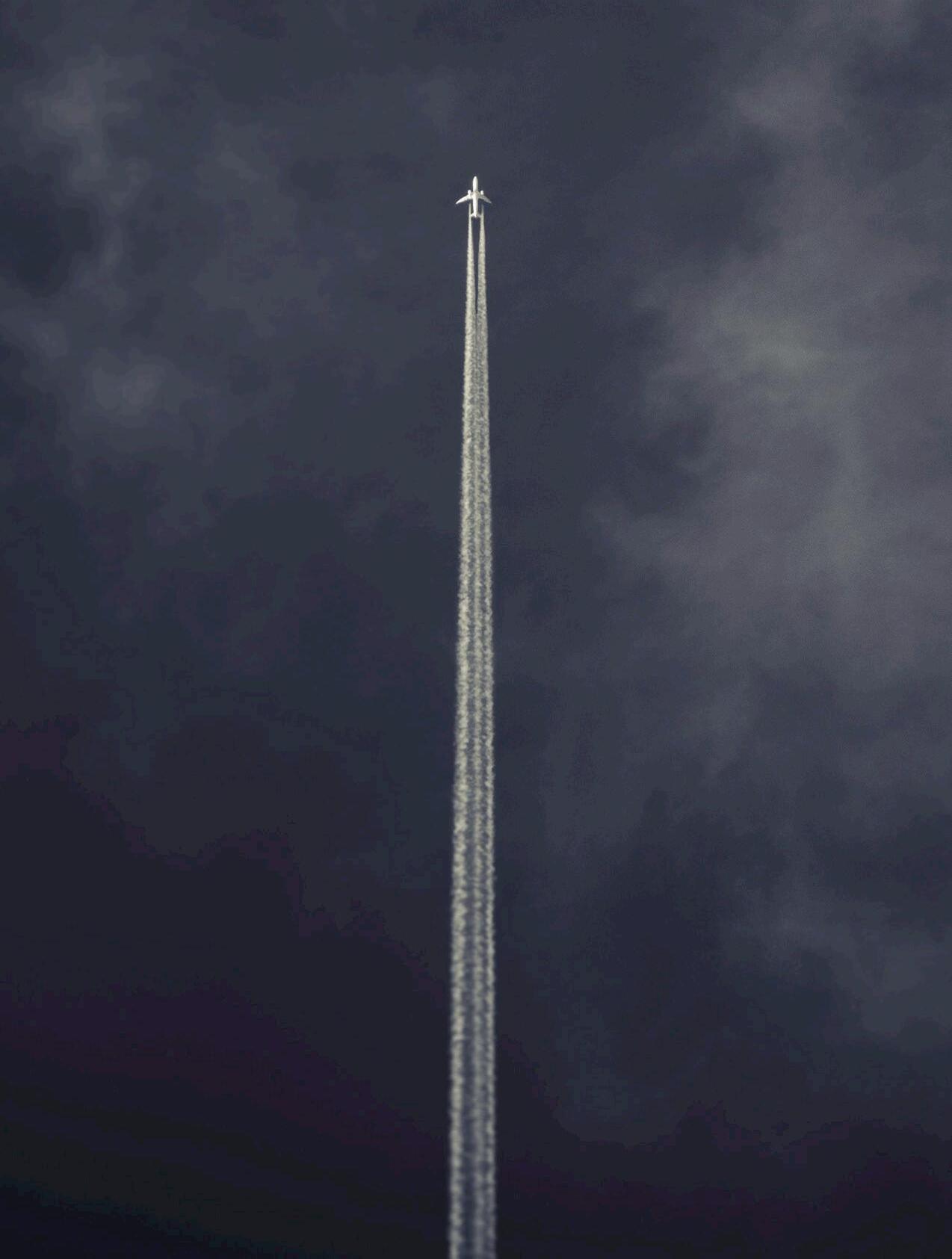
CAN THE MIDDLE EAST’S AIRLINE SECTOR WHICH INCLUDES SOME OF THE WORLD’S LARGEST AIRLINES MOVE THE NEEDLE FOR THE GLOBAL AVIATION INDUSTRY? WITH ITS CURRENT OUTLOOK, IT LOOKS LIKE IT ALREADY IS
WORDS VARUN GODINHO
The global aviation sector has spun 180-degrees from its abysmal performance in 2020 and 2021. To be fair, much of it was for reasons beyond its own making. That pivot though has led to a frantic recalibration of forecasts and expectations from the industry. The International Air Transport Association (IATA), for example, revised its forecast for 2023 saying that it now expects net profits from the airline industry to reach US$9.8 billion this year, more than double that of the US$4.7 billion it had previously predicted in as recently as December 2022.
Major airlines within the Middle East have no small part to play in this boom. Emirates reported its best year yet with a profit of US$ 2.9 billion for the year ended March 31, 2023, compared to a US$ 1.1 billion loss in the previous year (read our exclusive interview with the airline’s chief commercial officer on pg16). Flydubai said that it too recorded a profit of US$327 million for 2022, a year-on-year increase of 43 per cent, while UAEheadquartered low-cost carrier Air Arabia reported a 70 per cent increase in net profit to Dhs1.2 billion for the 12 months ending December 31, 2022.
IATA noted that it now expects 4.35 billion people to get onto an aircraft in 2023, which is not far off the 4.54 billion people who did so in 2019. By virtue
of its geographical positioning, the Middle East will be an increasingly important hub for people to catch their connecting flights. Little surprise then that Dubai International (DXB) retained its position as the world’s busiest international airport for the ninth consecutive year, according to the Airports Council International (ACI). There were 66,069,981 passengers who used DXB in 2022, a 127 per cent year-on-year growth. In May this year, DXB too revised its forecast saying that it now expects to host 83.6 million passengers in 2023, a significant increase from its previous estimate of 78 million.
Other airports within the region are also preparing to ramp up their operations. Notable among them is Hamad International which has undergoing a massive infrastructure upgrade with the eventual aim to host up to 70 million passengers annually. Towards the end of last year, it completed the first phase of its renovation project by way of which it can now host up to 58 million passengers. Apart from a new transfer hall, additional high-end retail and F&B options and a host of new lounges, the highlight was the opening of Orchard – an indoor tropical garden in the centre of the terminal which includes more than 300 trees and 25,000 plants. Also last year, Bahrain International inaugurated a new 210,000 sqm terminal which will help increase the airport’s capacity to 14 million passengers.
The ACI has predicted that by 2040, Middle Eastern airports will handle 1.1 billion passengers – more than double the 405 million passengers it did in 2019. Radical and rapid upgrades are therefore required to the airport infrastructure across the region. The highly-anticipated Abu Dhabi Airports’ Midfield Terminal is expected to open within the next few months, though no firm date to do so has yet been shared. It will be the home base for the UAE national carrier, Etihad Airways, and cover an area of 700,000 sqm. It will have an initial capacity to host around 30 million passengers annually, and process around 8,500 passengers an hour. It will have 156 check-in counters and 65 aircraft gates too. The central terminal itself is equivalent in size to 21 football fields put together

JULY-AUGUST 2023
WIRESTOCK /GETTY IMAGES
And there are other mega aviation infrastructure projects
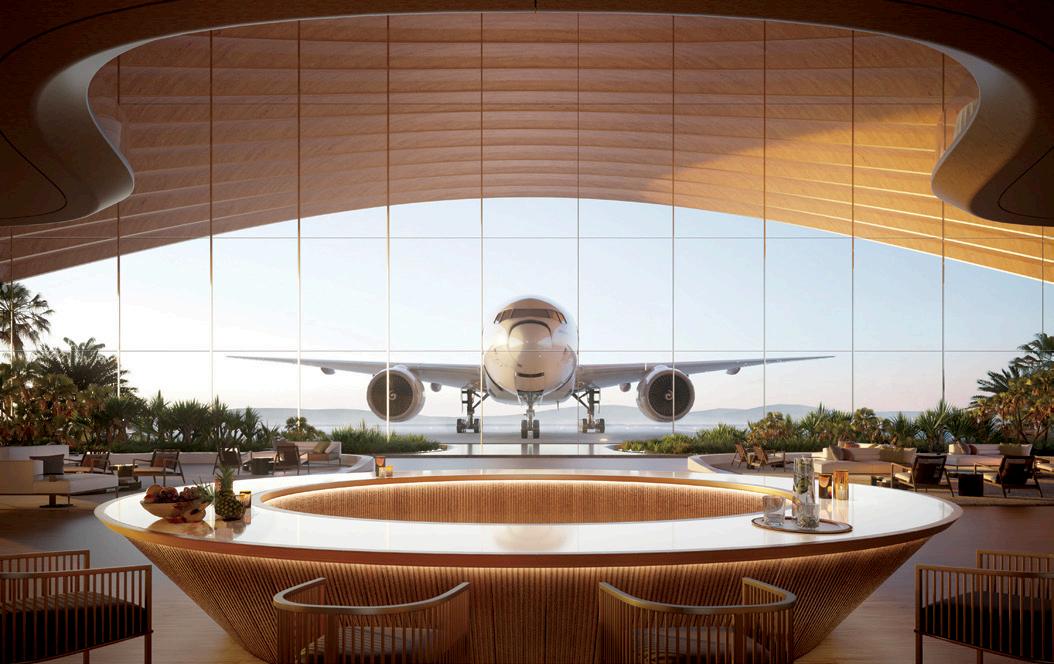
BUILDING THE MACHINE
coming up elsewhere in the Middle East
too While Saudi Arabia is already home to the world’s largest airport in terms of overall size – the King Fahd International in Dammam is spread over 776 sq km –another giant airport is being built in the kingdom’s capital of Riyadh. The King Salman International airport will be spread over 57 sq km and feature six parallel runways. It will be able to accommodate up to 120 million passengers by 2030, and is being designed such that it can increase that number to185 million by 2050.

With Qatar recently hosting the World Cup, Saudi Arabia liberalizing its tourism visa rules and the UAE becoming a model case study as to how business continued to be conducted despite the crippling pandemic, major airlines within the region have uniformly witnessed a growth in demand and have consequently expanded their networks.
“As an airline, we have a strategy of growth. It’s not related to my profit, but it’s related to what I want to be and where I want to be in a certain period of time. To measure an airline’s growth, it’s better to measure it that way because profit alone doesn’t direct our growth. The constant average growth of Qatar Airways has constantly been double digits so we must be doing something right,” Akbar Al Baker, Qatar Airways’ group chief executive, told Business Traveller at a media roundtable along the sidelines of Arabian Travel Market (ATM) in May.
The growth that the airline’s chief executive references was revealed at the ITB Berlin a few weeks prior where it said that it would start flying to seven new destinations this year, resume services to 11 more and increase frequencies to 35 points across its network. That growth will, of course, be supported by the airline growing its fleet – helped by the fact that earlier this year it reached an amicable settlement with Airbus over a legal dispute
21 COMMERCIAL AVIATION JULY-AUGUST 2023
ABOVE: The upcoming Red Sea International airport in Saudi Arabia
BELOW: Abu Dhabi Airports’ Midfield Terminal
FOSTER + PARTNERS
COMMERCIAL AVIATION
that it got into with the aircraft manufacturer regarding surface degradation of its A350. That chapter is now closed for Qatar Airways and Al Baker confirms that Airbus will remain in consideration for the carrier. “We have a fleet that includes both Boeing and Airbus. We still have a large Airbus order and a large Boeing order which they both have to deliver. We will grow our fleet by around 15 per cent in the current financial year, if the aircraft deliveries are on schedule,” said Al Baker.

The path that some of the region’s airlines are taking towards their individual growth starkly diverges at some points from their global counterparts. For example, Qatar Airways has indicated a bold decision where it intends to scrap first-class seats on the next generation of its long-haul aircraft. It’s a strategy that is drastically different from that of other major airlines such as Air France and Lufthansa which are focusing on growing their ultra-high-end offerings. But for Al Baker, the focus for his airline’s future would be its QSuite business class offering.
The business class is being revamped by other airlines too within this region. At the ATM this year, SAUDIA unveiled its new A321 XLR aircraft business class suite. Its Thompson Aero’s VantageSOLO product will be similar to what JetBlue uses on its A321LR aircraft serving its transatlantic routes to London.

At the same trade show in Dubai in May, flydubai also unveiled its new business class product called The Business Suite with features such as lie-flat beds and 17-inch 4K
LEFT: Flydubai recently unveiled The Business Suite product for its single-aisle aircraft
BELOW: The new business class interiors on Etihad's Boeing 787 Dreamliner

built-in touchscreens. “The Business Suite, designed exclusively for single-aisle aircraft, is the latest evolution in flydubai’s business class offering which will see 10 suites introduced to a number of our newest aircraft before the end of 2023. The new seat will offer all passengers in business class direct aisle access, which rivals the business class experience on-board many widebody aircraft,” flydubai’s CEO, Ghaith Al Ghaith, told Business Traveller.
Etihad meanwhile showcased its new business studio product which will debut on its incoming 787 Dreamliner fleet which will arrive in the third quarter of this year. The business studio cabin features a customised version of Collins' Elements seat, with Etihad being the world’s first airline to roll out an Elements seat on a Boeing 787. Also sprucing up its premium offerings is Emirates which embarked on a US$2 billion retrofitting project a few months ago that will see it overhaul 120 aircraft including 67 A380s and 53 777s by 2025. That programme will result in the refurbishment of 728 first class suites, the upgrading of more than 5,000 business class seats and the installation of 4,000 of the airline’s premium economy seats which it first announced last year. Its premium economy seats are already available on many of its key routes including New York JFK, London Heathrow, Melbourne and Singapore.
Another regional carrier which is betting on premium economy is Kuwait Airways which is only the second Middle Eastern carrier, besides Emirates, to commit itself to this class of cabin. Its new premium economy and business class seats will be fitted on the carrier’s A330 neo aircraft. It has a total order of seven A330-900 aircraft, having already taken delivery of four A330-800s. The airline carried approximately 3.5 million passengers in 2022 and hopes to raise that to 5 million this year, with plans to break even financially by 2025. But the premium segment while important, might not deliver the volume business for the aviation industry. That segment would likely be dominated by low-cost carriers. Travel data provider OAG said recently that low-cost carriers now make up nearly a third of overall global airline capacity. Here in the Middle East, Wiz Air has been raising the bar with that model. In a joint venture with ADQ, it established Wizz Air Abu Dhabi and took possession of its ninth new A321 neo aircraft earlier this year. In Saudi Arabia, Wizz Air has opened more than a dozen new routes to the kingdom from European cities including Milan, Rome, and Vienna to Saudi’s major destinations including Riyadh, Dammam and Jeddah. Another low-cost carrier, Air Arabia, also drastically grew the number of passenger it carried in 2022. At 12.8 million,
22
JULY-AUGUST 2023
We will take delivery of up to 15 more aircraft by the end of the year
GHAITH AL GHAITH, CEO of flydubai
it nearly doubled the number of passengers it carried last year across its seven hubs including Sharjah and Abu Dhabi, among others. At the end of the first quarter of 2023, it had 68 new Airbus A320 and A321 aircraft.
BUILDING THE ECOSYSTEM
Beyond airline product innovations and the acquisition of new aircraft, it is strategic alliances and government policies that will mark the growth of the sector. Take for example, a seminal announcement made by two of the biggest carriers in the UAE – Emirates and Etihad – which agreed on a new interline partnership wherein customers of either airline can purchase a single ticket and fly into either Dubai or Abu Dhabi on Emirates or Etihad respectively, and return via the other city’s airport on the partner carrier.
Over in Oman, another move by its national carrier is also expected to have ripple effects on the global aviation sector. Last year, Oman Air announced its intent to join the Oneworld alliance. When it does join the alliance by 2024, it will put the 30-year-old airline in a league of only three Middle East carriers – the other two being Qatar Airways and Royal Jordanian – and 14 full-member airlines globally. Government support too is crucial, and thankfully, it is forthcoming for Middle East carriers. After all, aviation is expected to be a major growth engine of national economies in this region. For example, the UAE’s aviation sector supports more than 770,000 jobs and contributes an estimated US$47 billion to the country’s GDP. Over in Saudi Arabia, the upcoming King Salman International airport in Riyadh is being backed by the country’s powerful sovereign wealth fund, the Public Investment Fund (PIF). That airport project alone is forecasted to contribute SAR27 billion annually to the country’s non-oil GDP and generate around 103,000 jobs.
For Saudi Arabia, the aim is to connect to 250 cities around the world by 2030 and getting to that figure will
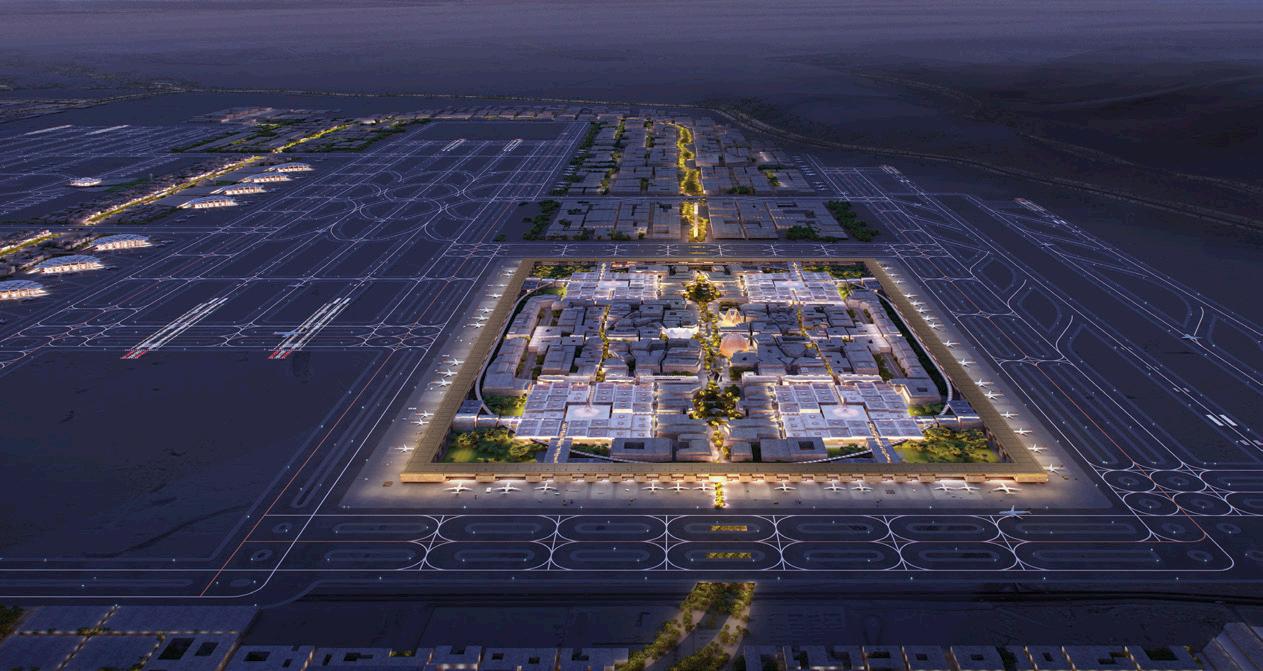
4.35 BILLION
US$9.8 BILLION
require a coordinated national aviation strategy. To that end, the Saudi Air Connectivity Program (ACP) was established in 2021 by way of a Ministry of Tourism initiative to coordinate the activities of the different airlines founded within the country, and also for international airlines seeking to establish routes to the kingdom.
International airlines, specifically North American carriers, are queuing up to ramp up services to the region. One of the biggest is United Airlines which resumed services to Dubai after exiting the market in 2016. Earlier this year, it launched a new nonstop daily service between its New York/Newark hub and DXB thereby becoming the only US airline to offer nonstop flights between Dubai and the US.

“United is the largest US international carrier, by far. We have over 200 widebody jets flying around the globe every day and we have 100 widebody jets on order from Boeing,” said Andrew Nocella, executive vice president and chief commercial officer at United. United has struck a codeshare with Emirates to facilitate its operations to Dubai. “The Emirates connection in Dubai allows us to access entire parts of South East Asia via the Emirates network that we don’t have efficiently on the current United Airlines system,” added Nocella.
It is sound rationale as Air Canada, Canada’s largest airline, also said that it would introduce a nonstop Vancouver-Dubai flight this October, augmenting its current daily TorontoDubai service. Air Canada also activated a codeshare with Emirates towards the end of last year that allowed it to expand its reach deep across Emirates' network.
STATE OF THE INDUSTRY
The number of people expected to fly in 2023
Forecasted airline industry net profits for this year
23 JULY-AUGUST 2023
*According to IATA
TOP: A rendering of the King Salman International airport in Riyadh ABOVE: United Airlines restarted flights to Dubai earlier this year
BUILDING THE FUTURE
According to IATA, the production of sustainable aviation fuel (SAF) is expected to exponentially increase over the coming years. IATA estimates that in 2022, more than 300 million litres of the fuel was produced – an enormous increase from the 8 million litres that were made in 2016. Encouragingly, it predicted that 5 billion litres will be produced annually globally by 2025. IATA adds that SAF will likely contribute to 65 per cent of the emissions reduction required for aviation to reach net-zero by 2050.
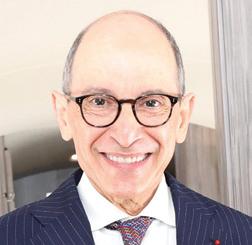
Here in the region, airlines are stepping up to the plate to do their bit too. In May, Emirates committed US$200 million to fund R&D projects focusing on reducing the impact of fossil fuels in commercial aviation over the next three years. It stressed that the fund will not be used to purchase SAF or carbon offsets – which it is already doing parallelly – but will be funnelled exclusively into R&D.
Qatar Airways is also engaged in the conversation around sustainability. “We are playing a role in the research and development of SAF in Qatar University where they are researching the production of SAF from algae,” reveals Al Baker, while being frank about the current constraints on the use of SAF. “The problem with SAF is its availability. When it is available, there are such small quantities of it and it is so exorbitantly expensive
that we cannot afford it. There are no economies of scale.”
Economies of scale are crucial for mass adoption given that fuel costs are often the single most major expense for an airline. Emirates, for example, said that fuel accounted for 36 per cent of its operating costs in 2022-2023, and that figure is similar to what United spends (approximately 30-35 per cent) on jet fuel. While oil hedging is touted as a possible solution, it’s not one that United entertains. “Oil hedging is an expensive bet. We have thought about this carefully and it’s difficult for us to predict the price of oil. We use the forward curve like anybody else would in this business. And when we look at the cost of the insurance policy to buy an oil hedge for an airline that is the size of United, we end up moving the market because of the amount of oil that we use. So, we determined years ago that it did not make sense to hedge the price of oil. There are moments in time where that seems to be a small disadvantage, but over the whole cycle, it’s been a significant advantage,” says Nocella.

24 COMMERCIAL AVIATION JULY-AUGUST 2023
The problem with SAF is its availability. It is exorbitantly expensive. There are no economies of scale
AKBAR AL BAKER, group chief executive of Qatar Airways
Volatile oil prices are only one aspect causing a degree of uncertainty in the prospects of the region’s carriers, but none are currently so insurmountable to push the industry off its current course. “[We’re] navigating through challenging times characterised by continued fluctuating fuel prices, disruption to supply chains, rising global inflation and geopolitical unrest, [which] did not dampen our strong performance last year. Flydubai will grow its capacity across the network by 20 per cent between July 1 and September 30, 2023, compared to the same period in 2022. We have grown our fleet of Boeing 737s to 78 aircraft. We will take delivery of up to 15 more aircraft by the end of the year,” says Al Ghaith.
There’s immense optimism for what is to come. Much of that buoyant spirit is represented by Riyadh Air, a brand-new Saudi airline backed by the PIF and helmed by Tony Douglas, the former group CEO of Etihad Aviation Group. Having already confirmed an order for 39 widebody 787-9 Dreamliner aircraft, and an option to acquire 33 more, it has already obtained its ‘RX’ airline designator code ahead of its first passenger flight which is being slated for early 2025 with promises to connect to over 100 destinations from Riyadh. In the meanwhile, a Boeing 787-9 Dreamliner painted in the airline’s distinctive indigo livery conducted a low-altitude demonstration flight in June over the Saudi capital city after which it is named.

In the northwest of Saudi Arabia, another brandnew carrier, NEOM Airlines is expected to take flight next year. Not far away from its base in NEOM, will be the upcoming Foster and Partners-designed Red Sea International airport which will be powered by 100
per cent renewable energy, and is expected to become the region’s first carbon-neutral airport, setting new benchmarks in the process.

The larger question is whether the Middle East will be able to move the needle for the global aviation industry? A glimpse of its ability to do so came through earlier this year when SAUDIA and Riyadh Air together placed a multi-billion-dollar deal to order up to 121 Boeing aircraft in what will be the fifth-largest commercial order by value in the US manufacturer’s history. That Saudi order can potentially support nearly 100,000 direct and indirect jobs and more than 300 suppliers from across 38 states, including 145 small businesses across the US. It's globalisation at its very best, with this region’s aviation sector in the pilot’s seat.

25 JULY-AUGUST 2023
ABOVE: Riyadh Air during a low-altitude flight over the Saudi capital
TOP RIGHT: Dubai International was ranked as the world's busiest international airport RIGHT: The Garden lounge by Qatar Airways at Hamad International
OPPOSITE PAGE: Qatar Airways' premium cabin
Hotforspotchange
Dubai is leading the charge when it comes to sustainable innovation and growth
WORDS JOSEPH PHELAN
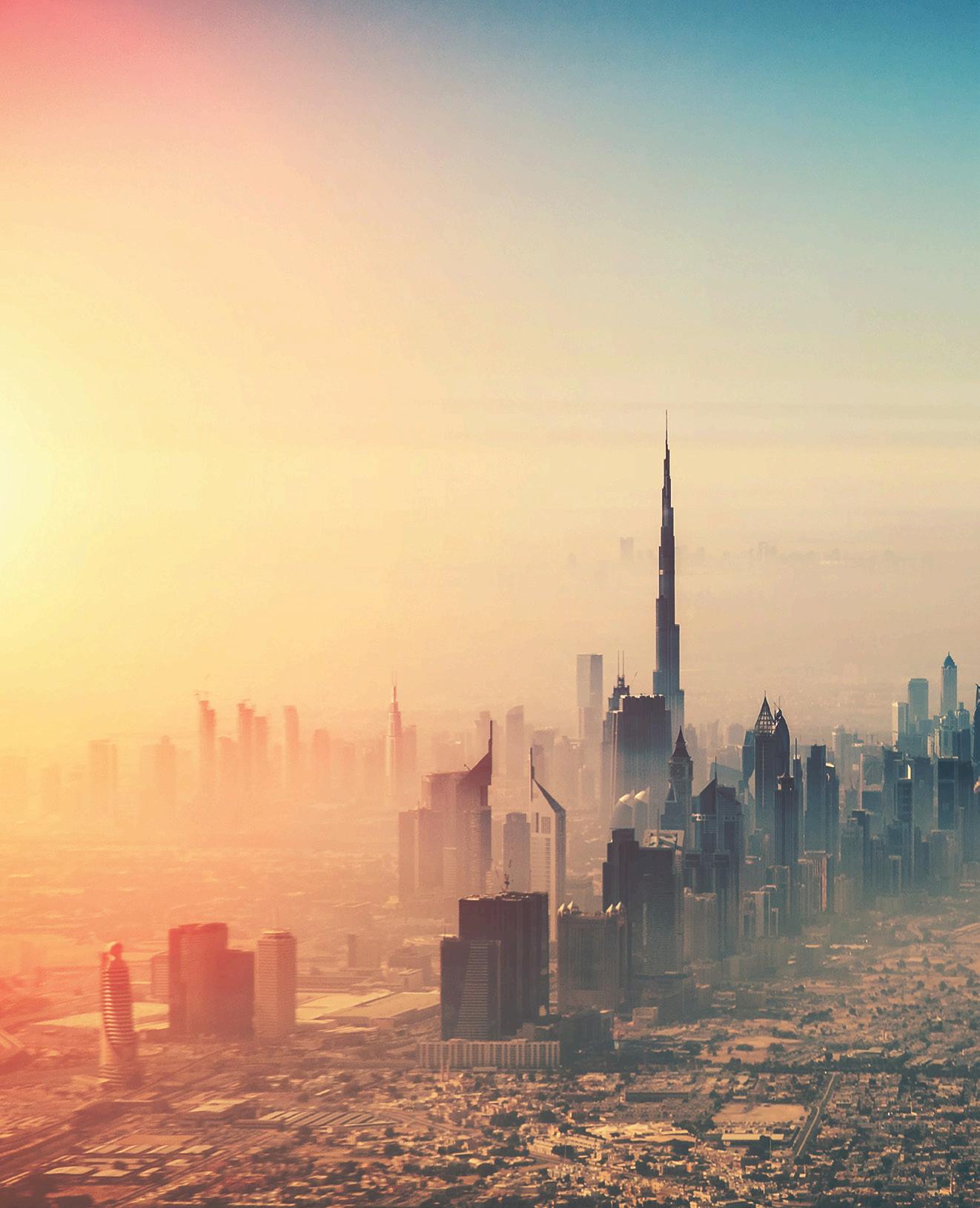
SUSTAINABILITY JULY-AUGUST 2023
THIS PAGE: Emerging from the desert, Dubai is home to improbable feats of engineering such as the 828-metre Burj Khalifa, the world’s tallest skyscraper

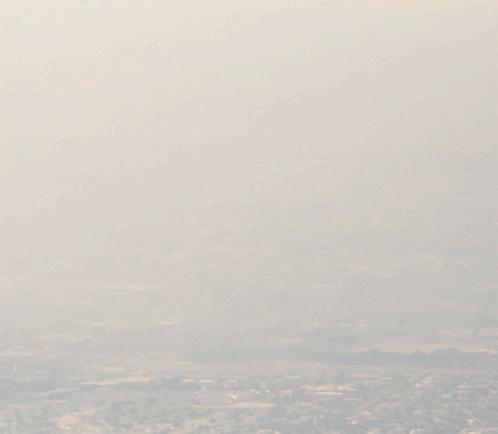

Irecently spent a week in Dubai’s desert, prowling the sands in a modi ed Land Rover in a bid to observe some of the Middle East’s most elusive residents. I glimpsed an abundance of incredible wildlife – the Arabian oryx, various owls, lizards, eagles, vultures, amingos – yet it’s a far from natural sight that sticks in my mind above all others: the ethereal, sparkling Mohammed bin Rashid Al Maktoum Solar Park.
Rising from the dunes like an alien cra , the solar park – the largest single-site solar park in the world – is both a staggering feat of engineering and progressive thinking, and an aweinspiring, almost celestial vision. e park provides clean energy for tens of thousands of Dubai residents, and since its launch, has trimmed Dubai’s carbon emissions by around 214,000 tonnes a year. By 2030, it will be reducing approximately 6.5 million tonnes.
In many ways, the solar park epitomises Dubai’s ongoing obsession with both being green and also the emirate’s devotion to bringing the inconceivable to life. Dubai is a place that has, for decades, enabled innovative, determined thinkers, architects and artists to pursue their wildest dreams – the Burj Khalifa, Palm Jumeirah, Cayan Tower and Ain Dubai are testament to that.
is mentality is, if anything, quietly becoming more pronounced. Dubai is rmly on the way to becoming a global eco superpower. It has the ambition, drive, impetus and nancial backing to make big things happen, and given the emirate’s history of surpassing even the most aspirational of
targets, the world is now sitting up, taking note, and getting very excited.
A city in the sand

Dubai, the UAE’s most populous emirate, is an improbable, implausible beacon of ingenuity and technological accomplishment. It’s a city that, to all intents and purposes, shouldn’t really exist, yet exist – and thrive – it does. On the face of it, Dubai and its neighbouring emirates have very few of the ingredients needed to sustain a population of millions. Around 80 per cent of the UAE’s surface area is desert, it rains a mere 25 days per year, and it has little arable land. Indeed, until relatively recently the country was sparsely populated, with only a smattering of hardy souls calling it home. To put that in some context, in 1950 the UAE’s population was approximately 70,578. It’s now verging on ten million.
e UAE’s meteoric rise from tranquil Middle Eastern backwater to ultra-modern commercial superpower is best illustrated by Dubai. Over the last ve or so decades, it has transformed from an insigni cant shing village to a colossal, sprawling metropolis, a hub of commerce, industry, nance and international trade. It has also simultaneously established itself as one of the world’s most popular holiday destinations.
e city has become a byword for modernity, a shining example of what can be done with the right amount of imagination, resourcefulness, investment and endeavour. Yet its success story is not without its caveats. In 2008 the WWF ranked the UAE as the country with the world’s worst eco-footprint, and the region has o en come under re for some of its less-than-sustainable practices, such as being compelled to import 85 per cent of its food, or the fact that the vast majority of its water – upwards of 90 per cent – comes from energyintensive desalination plants. Dubai, being the region’s largest city, has understandably borne the brunt of the criticism.
JAG CZ/GETTY IMAGES
27 JULY-AUGUST 2023
Dubai is a place that has enabled innovative thinkers to pursue their wildest dreams
“There is no doubt that there are some environmental challenges to the natural environment in Dubai. This includes a high carbon footprint, limited water resources, waste generation, and air pollution. However, Dubai has recognised the need to balance economic growth with environmental conservation and is actively promoting sustainability in various sectors,” says professor Mercedes Maroto-Valer, deputy principal (global sustainability) at Heriot-Watt University and director of the UK Industrial Decarbonisation Research and Innovation Centre (IDRIC).
There is, undoubtedly, cause for green optimism. Dubai, perhaps more so than anywhere else in the world, has made a habit of proving itself capable of comprehensive, systemic transformation. It has time and again embraced change and emerged stronger as a result – and its focus is now firmly set on becoming a global eco pioneer.
A planet-first approach
Dubai’s leaders have pledged not only to do things better, but have also vowed to develop and spearhead the world’s much-needed green revolution. As ambitions go, they don’t really get much bigger.
Its mission started as all such projects should: by addressing its own shortcomings. The Dubai Supreme Council of Energy has, for example, decreed to increase its share of clean energy to 29 per cent by 2030, and announced plans to achieve net-zero emissions by 2050. Additionally, Dubai Electricity and Water Authority (DEWA) launched a Dhs100 billion (US$27 billion)
Dubai Green Fund to facilitate the financing of clean energy projects. As if to further demonstrate the emirate’s green focus, in 2022, the Dubai Police became the first police force in the world to go carbon neutral.

“[Dubai] is taking leading steps in promoting sustainable practices and environmental conservation in the Middle East, and is a great example
for arid regions around the world who want to advance their sustainable infrastructure,” says Maroto-Valer.
“Dubai Municipality won first place in four categories at the Energy Globe Award 2022. The winning projects include the Municipality’s conservation labs, which incorporated an energy management system to optimise energy consumption.”
Several large-scale infrastructure projects also go a long way to
successfully showcasing Dubai’s lofty green credentials. The Dubai Sustainable City, for example, is the first operational net-zero energy city in the emirate, and has been designed partly to showcase the viability of world-class, high quality, low-energy living. The Dubai Metro, a state-ofthe-art, driverless metro system that runs on electricity and provides a low-emission alternative to traditional modes of transportation, has not only

28 SUSTAINABILITY JULY-AUGUST 2023
WENJIE
DONG, KERTU_EE/GETTY IMAGES
THIS PAGE: Dubai has recognised the need to balance economic growth with environmental conservation, investing in things such as solar panels and modern public transport
increased travel efficiency, but also reduced traffic congestion and air pollution in Dubai.
The Museum of the Future, opened in 2022, is already one of Dubai’s most popular attractions – it had more than one million visitors in its first year –and is home to art exhibits, immersive displays and in-depth examinations detailing what’s likely in store for our fragile planet. It is a groundbreaking, important undertaking, and one that highlights Dubai’s commitment to prioritising environmental projects, and disseminating vital knowledge far and wide.
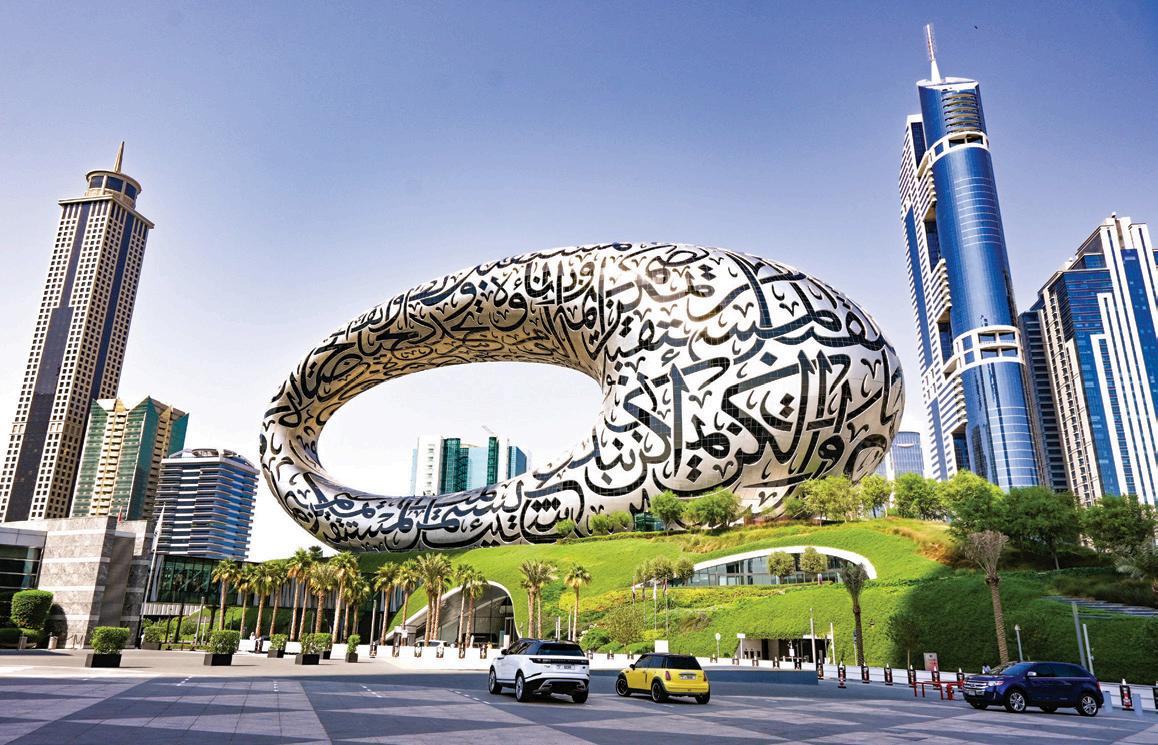
An all-encompassing agenda
Of course, sustainability and its associated long-term eco benefits can only truly be achieved if there is wholescale buy-in, not only from government and its various public bodies, but also from the private sector. This is something Dubai has recognised, and is an approach scores of businesses, especially those in the
hospitality sector, are fully aligned with.
Since March 15, 2023, Dubai hotels have been mandated to submit their consumption of nine carbon emission sources, including electricity, water, district cooling, liquefied petroleum gas, landfill waste, recycled waste, petrol, diesel and refrigerants. This information is then assessed to provide detailed insights on the sector’s overarching performance, and to provide advice and guidance that will catalyse improvements across the board.
Numerous hotels have been ahead of the game for a while. The H Dubai, for example, has been awarded the Green Key Certification by the Emirates Green Building Council on multiple occasions, owing to its
dedication to being green and also for continually seeking out new ways to improve performance. Its latest investment, an advanced biodigester that intelligently breaks down organic material, managed to reduce 3.9 tonnes of carbon emissions in its first two months of operation.
Al Maha Desert Resort and Spa, a romantic desert resort that puts a modern spin on the traditional Bedouin village, has also taken the sustainability bull by the horns. In the last few years it has implemented a host of green initiatives, from the introduction of LED lighting and solar panels to reducing its water and energy consumption, and converting used oil into biodiesel. It also donates 5 per cent of its annual profit to the Dubai Desert Conservation Reserve, a national park that protects the region’s fragile flora and fauna.
Restaurants are also getting in on the act. Teible, which provides an authentic yet entirely modern take on traditional Middle Eastern
29 JULY-AUGUST 2023
ONDREJ BOCEK/UNSPLASH
In 2022, the Dubai Police became the first force in the world to go carbon neutral
THIS PAGE: The striking Museum of the Future
food, sources around 95 per cent of its ingredients from within the UAE, and recently installed an eco-friendly wood wool ceiling. It won a Michelin Green Star this year. Lowe, another restaurant that avoids single-use plastics and imaginatively uses leftovers to create new dishes, retained its Michelin Green Star for its approach to sustainable gastronomy. Folia, based in the Four Seasons at Jumeirah Beach, partnered with Tiny Footprint, the world’s first carbon negative coffee company, to minimise the impact of caffeine consumption.
Going green is almost becoming competitive in hospitality, with hotels and restaurants vying to do things
better than their competitors. They are actively pursuing ways to make a positive difference, and such cordial – yet eminently serious – rivalries are sparking creativity and fermenting tangible positive change. In Dubai, going green is now far more than just a good thing to do – it’s a necessity for long-term success.
Attracting eco-friendly businesses
Dubai’s green agenda has, somewhat unsurprisingly, made it a magnet
for eco-conscious startups, such as Desert Control, a groundbreaking initiative that has developed a chemical-free ‘liquid natural clay’ solution capable of turning desert sand into fertile soil.

More than 20 per cent of the planet’s fertile land is degraded to some extent, and it’s getting worse by the day. Deserts are spreading, valuable land is being lost, and some of the world’s poorest regions are on the cusp of being all-but decimated as a result. This sorry state of affairs, when coupled with a growing global population, is a recipe for widespread disaster.
“Evidence shows that soils are eroding and degrading faster than they can form,” explains Dr Daniel Evans, an expert on soils and biosciences at Cranfield University. “The result is that soils are thinning globally. In many regions, this imbalance has led to the exposure of the underlying bedrock or parent material. Research and innovation is essential to develop smart, efficient, scalable solutions to reverse these desertification processes and start forming soil.”
Desert Control is just one of hundreds of forward-thinking companies attempting to tackle significant worldwide problems, and the backing such operations receive in Dubai could be crucial to overcoming all manner of global challenges. Indeed, Expo Live, a project launched on the back of the wildly successful Expo 2020 Dubai, recently announced that it will award a raft of US$50,000 grants to small companies that are addressing reforestation, the cutting of greenhouse gases, and improving the quality of agricultural practices.
A greener way
The city’s sustainable infrastructure and green initiatives could, conceivably, also attract a new segment of visitors interested in ecotourism and sustainable travel. Dubai has already started to promote its green initiatives through events

30 SUSTAINABILITY JULY-AUGUST 2023 GCSHUTTER/GETTY IMAGES;
ZAFEERAH HEESAMBEE/UNSPLASH
In Dubai, going green is more than just a good thing to do – it’s a necessity for long-term success
ABOVE: Dubai-based startup Desert Control has developed a chemical-free liquid natural clay that turns sand into soil
such as the Dubai Sustainable Tourism Awards, which celebrates hospitality establishments that are driving environmental awareness. The emirate has also started to better advertise the appeal of its desert and mountain regions, with an uptick in tourism in such areas providing additional funds to protect and enhance Dubai’s natural environment.
“Such initiatives demonstrate Dubai’s commitment to sustainability and show that it is not just a luxurious holiday destination,” Maroto-Valer adds. “Over the coming years, I believe there will be an increased focus on showcasing Dubai’s sustainability and green initiatives.”
Dubai is not only an incredible success story, but one that, only 50 or so years ago, would have been all-but impossible to predict. In recent decades it has expanded and matured at a spectacular pace – but is such growth sustainable? Will the city continue to flourish as we push into a future set to be dictated by renewable energy, green technologies and environmental preservation?
“Predicting what Dubai will look like in 50 or 100 years is challenging
as many factors may influence the city’s future trajectory,” admits Maroto-Valer. “However, based on current trends and developments, I believe Dubai’s economy will continue to grow and the city will retain its status as a world leader in sustainable projects while becoming more self-sufficient.
“Due to the vast investment opportunities and flexible policies attracting foreign investment, there will likely be continued demand for new infrastructure, housing, and commercial developments. Dubai has already made significant investments in renewable energy and desalination technologies as it looks to diversify its energy sources and reduce its dependence on thermal power.
“Having already implemented several ambitious sustainable projects, including the world’s largest solar power project and the world’s first 3D-printed commercial building [designed by the Dubai Future Foundation], I expect Dubai to continue to push the boundaries and develop innovative solutions for environmental challenges.”
NEW HOTELS
Dubai’s skyline is continually altering, with new developments and attractions popping up almost daily. Nowhere is this more evident than in the hotel sector.

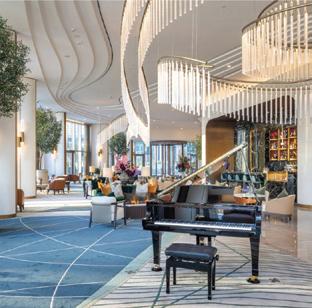

Atlantis The Royal, which opened its doors at the beginning of 2023 to much fanfare, is already an iconic establishment worthy of the Atlantis name. Not only does it offer a luxurious, wholly grand hotel experience, but it is also putting sustainability at the fore. It has, for example, pledged to stop using single-use plastic bottles by 2024.
■ Address Grand Creek Harbour, the first five-star hotel to be located in Dubai Creek Harbour, has been winning plaudits since its launch in January 2023. Offering unrivalled views of the city’s skyline, and with a plethora of amenities – pools, restaurants, spas, lounges – to enjoy, Address Grand Creek Harbour is already making waves in the hotel scene.
■ NH Dubai The Palm opened its doors in February on the iconic Palm Jumeirah. Situated on the exclusive Palm West Beach, guests have direct access to the beach and promenade. The hotel features 227 guest rooms and suites, plus 306 serviced apartments. Facilities include a sunset-facing rooftop infinity pool and the NH Collection Premium Lounge.

31 JULY-AUGUST 2023
NAPA74, STEFAN TOMIC/GETTY IMAGES
LEFT: Atlantis, The Palm overlooks the Palm Jumeirah
AIR MILES WITH
Hisato Hamada
eaters. And that was the whole reason I’m doing this, which is to showcase this product and the entire world of wagyu. So, when this opportunity came up, I decided it’s been four years since I rst performed in this region, but now I have a permanent restaurant so I can do it every day.

Which is the most exotic holiday you’ve been on? Wadi Rum in Jordan. ere was no reception or wi , so I cancelled three meetings without any notice. ere is no sound there, but you still feel an unimaginable sound in your ears. It’s just so quiet, and coming from Japan, it’s very zen. I was excited to feel a sense of zen in the Middle East.
What is your earliest memory of a holiday as a child? It was of visiting Heron Island in Australia back in the 1980s. We were eating breakfast outside when a bird pooped on my omelette…I think I ate it anyway.
The chef-founder of Tokyo-based WAGYUMAFIA has expanded his restaurant concept into Saudi Arabia with the aim to export the love for wagyu to customers across the region

How did the idea for WAGYUMAFIA come about? e idea came from house parties that I used to throw. I just wanted to deliver the full capability of what a product like wagyu can do. Before WAGYUMAFIA, the wagyu experience was one where you would sit for three hours and get a small portion to taste. I wanted to rede ne that experience of wagyu. Wagyu can elevate your food, but a lot of people don’t do that because it’s an expensive item. But for house parties, you don’t care about the cost…people just bring what they want to eat and they will bring their most expensive wines and food. So, [the idea of] rede ning the wagyu experience and the perception of it came from a house party.
You are a self-taught chef. How did you train? I enjoy cooking, I don’t feel any pressure because I love to cook. Since I was three, I loved being in the kitchen with my mom, learning about ingredients and techniques, cooking and eating. It helped me develop a fondness and appreciation for making food.
What are the lengths that you will go to in order to find the finest beef? When it comes to branded cows like Kobe and Ozaki, which are already at the top of the pyramid, we use only the top 1 per cent of those high-end cows. I have visited around 250 farms and singled out around 20 farmers to work with. I use only about ve farmers regularly, though occasionally I rely on up to 15 more. From day one, I have hand-selected every cow with the farmer. Sometimes, I also select the country where the beef will go, whether that’s Hong Kong, Singapore or Saudi Arabia.
You’ve brought your concept to Saudi Arabia. How exciting is that market for you? Very exciting. We didn’t plan to do Riyadh Season back in 2019, but it was a very last-minute decision. It was one of the most memorable moments of my career, because it was the rst time we served so many rst-time wagyu
What are the three things that you always pack in your suitcase? Swimming trunks, running shoes, and a hair clipper to cut my own hair.
How do you spend your air miles? I have so many, I’m not quite sure how to use them. But I know they are piling up, so I should decide soon.
Which is the one travel experience you’d rather forget? On one of my trips from Tokyo to Chicago, I ended up spending 10 hours in customs custody, and then was deported from the US and had my visa taken away. It’s a good life memory now, but at the time it was not a great experience.
Which markets will WAGYUMAFIA expand to next? Las Vegas and Miami are next. For the Middle East, so many projects come to mind. I want to bring more of the authenticity of Japanese cuisine to this region.
INTERVIEW VARUN GODINHO
32 AIR MILES JULY-AUGUST 2023
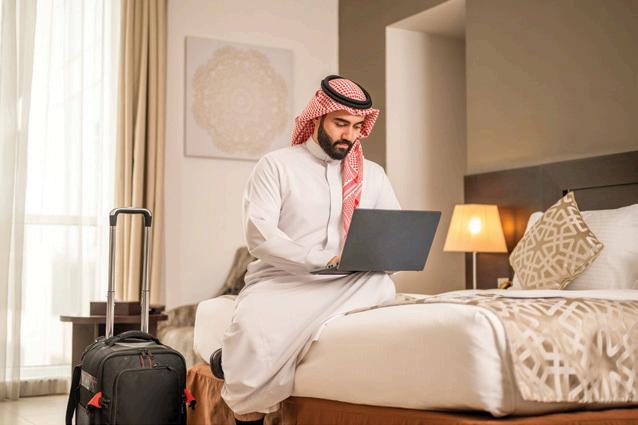
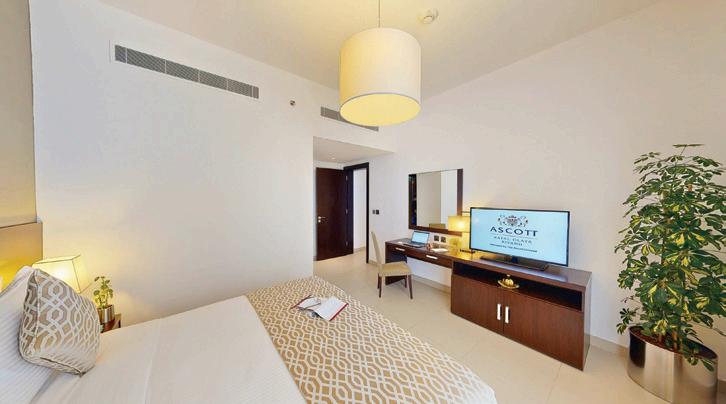


HOTEL VIEWS
DESTINATION
DOHA
Christian Hirt , managing director for Raffles and Fairmont hotels at the Katara Towers in Doha, elaborates on the steps that the two properties are taking to remain at the forefront of the city’s hospitality sector
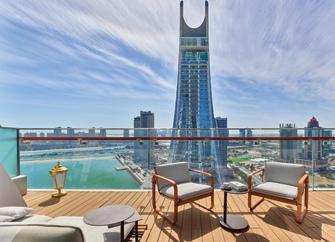
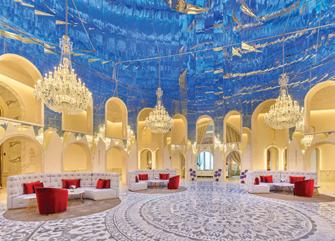


INTERVIEW VARUN GODINHO
What are some of the recent activations within the two hotels? Post the World Cup, we started all our food and beverage activations in our restaurants and also our entertainment concepts. We started conducting events on the rooftop Acoustic Music Penthouse [in the Raffles]. This year, we took our Ramadan tent seaside, and we had a beautiful Iftar and Suhoor offering in our garden, spanning between the Raffles pool all the way to the Fairmont pool. As for our spas, we always make sure that whatever we do between the two hotels complements each other. In Fairmont, we focus on active well-being, nutrition and recovery, and in Raffles, we’re focusing on advanced beauty and well-being. We’re working with leading experts such as Dr Burgener and Bastien Gonzalez.
Which are some of the standout culinary offerings at the Fairmont and Raffles?
Provok Asian Project in Fairmont has eclectic cuisine that’s pushing boundaries. We have an amazing beverage concept there. We have a beverage lab that is common to the two hotels, and our beverage director has come up with exceptional creations including zero-alcohol beverages. Masala Library by Jiggs Kalra, our contemporary Indian concept, is also an exceptional restaurant. The food, the attention to detail and the presentation are second to none.
Of course, we have Alba by Enrico Crippa in Raffles which is doing very well. We have a chef’s table in the kitchen which is great fun. And then there is the Blue Cigar lounge in the Raffles where we have 6,500 books and the largest cigar selection in the country. As
part of its programming, we link the food and beverages concept there to the literature available in the library.
How have you collaborated with Qatar’s government entities to promote your hotels? We are receiving wonderful support from Qatar Tourism and Qatar Airways. We had an activation with Paris Saint-Germain, and that came through our partnership with Qatar Tourism. We’re working right now on a very big piece with Qatar Tourism that will be in our hotel and which will promote the entire country. With Qatar Airways, we work very closely in particular with their Discover Qatar programme. We work with them on events such as Formula One. We also have activations together at the ATM and other trade shows.
What’s been the steepest personal learning curve about the Qatar hospitality market? The biggest learning was that the lead times with which we receive requests for large groups and important bookings are short. This is something that I have experienced more in Qatar than in other destinations. A lot of the business that we’re picking up for a specific month, is secured within that month itself – it can sometimes be over 50 per cent of our business. That, of course, has an implication on planning and so we have to plan ahead and be more flexible.
Is attracting and retaining human talent a challenge? Across the two properties, we have just under 1,000 employees. With the World Cup held in Qatar, we had less of an issue attracting talent, but the challenge now
is to retain them. A lot of that has to do with motivation and long-term career planning. That’s where our brands come into the game, because if we want to develop our talents, we need to make use of all our brands. Surely, the right mix of benefits have to be in place too.
What is planned for the hotels over the next few months? We have a floating island on the water, the Privée Island Club, which is built as a reflection of the towers on the water, and will open in the middle of September. We will have a mini spa, private cabanas, a restaurant, bar and boutique, and all of this will be available exclusively for the residents of the hotel. We are also working on bringing artists and conducting concerts in the Katara Hall over the summer. We’re working on culinary enhancements with guest chefs and travelling mixologists and will also have a culinary festival which will kick off after the summer. Towards the end of the year, we will start the sale of our residences.
34
JULY-AUGUST 2023
Calling all podcasters and content creators!









Whether you are looking to record, edit or manage your podcast, our fully equipped podcast and video recording studio has it all.
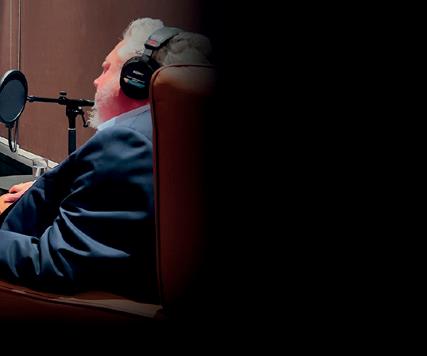
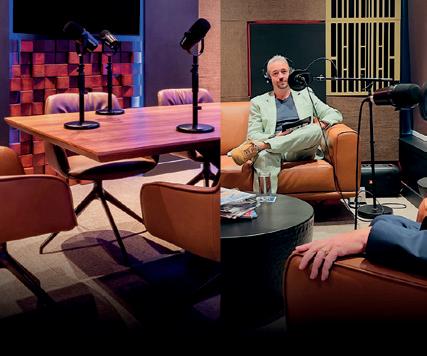



+971 4 427 3000 | podcast@motivate.ae BOOK YOUR STUDIO motivatemedia.com
Who should run airport lounges?
I’m dissatisfied with the quality and service of airline-run lounges. Why? Because with a few exceptions, they have moved from being havens of tranquillity and rest to upmarket cafeterias. The spaces are crowded, no one knows who I am, I have to line up for food and I have a limited drinks choice that I usually have to serve myself. I sit in tired chairs that would be unsuitable for a doctor’s surgery and periodically have to get up to see if my flight has been announced, is boarding, or has left without me.
Most of the non-airline operated lounges are no better. Getting in is the first problem. Whenever I want to use an independent lounge, I am refused entry. Why? Because despite my qualifying membership cards or ready cash I haven’t made a chargeable reservation in advance. When I do gain access, I find a food buffet that if it were not for extreme hunger, boredom or frustration I would walk straight past, and a bar presumably stocked by residents of Sparta.
LUKEWARM RECEPTION
The same mediocre standards seem to prevail across most airports.
Doubtless the operators will explain that regulations, costs and Covid-related staff issues have impacted performance, and that the cost of food and beverage is in a rising inflationary spiral. Perhaps I might have a little grace and recognise that difficult trading conditions and the consequent knock-on of staffing challenges have meant that times might be lean. However, where is the warm welcome of hospitality and the personal attention to detail?
Surely what is needed are lounge operators backed by an excellence-driven organisation. Isn’t it time for those hoteliers
who understand great service, appreciate ambience and can offer value for money to be involved? It has happened before. The Peninsula Hotel in Hong Kong once operated fine lounges for Cathay Pacific where the food and beverage offerings as well as the plushness of the interior design matched the reputation of the hotel. The contract appears to have terminated with the development of Cathay’s own airline food and beverage expansion. However, at the time, their involvement demonstrated that hoteliers can make a better fist of it than caterers.
More recently Accor in Australia announced a new agreement with Qantas that heralds an improved offering in their major hubs of Sydney, Melbourne and Perth. Here, the ability of a well-qualified hotel brand with support across the region will be able to bring in not just the food and beverage quality required but also a sense of hospitality that, to me, seems to have disappeared in all but the most exclusive lounges.
In the Middle East, Dubai hoteliers are leading the way for business travellers. Given that flights often arrive early in the morning when hotel rooms are not available for immediate occupation, several hotels are now offering arrival lounges. One such is the Dubai International Hotel which operates ‘The Gallery’ in Terminal 3. Also in Terminal 3 is Jumeirah’s arrivals lounge where “leisure meets luxury”. Are these lounges better than what is available from Emirates? Not in scale, but the emphasis on
service is where they make the difference. Their attention to pre-arrival detail means they know your name and they know what you like as well as seamlessly managing your transfer to your chosen hotel.
So what is the inhibitor for hotel groups to get involved? Certainly, only those with a wide spread of geographic locations and reputation could be serious contenders, but it appears that in most prime international destinations the space available and the limitations of longer leases are the main detractions. That and the logistical issues to ensure brand integrity in terms of food quality and service are maintained. On top of that, airport restrictions can prohibit the delivery of quality service from operators outside of union agreements.
For the business traveller there are thankfully some that achieve high standards: the first class lounges of British Airways and Cathay Pacific, for instance, as well as Virgin’s Clubhouse at Heathrow and Qatar Airways’ facilities in Doha. Generally, the airlineoperated lounges are at a better level than the independents.
Is it time for independents to join in partnership with some of the leading hotel brands? New airport expansions in Asian destinations like Thailand and China could provide an incentive, and opportunity might be on the doorstep for groups like Mandarin Oriental or Minor Hotels to start a new trend in airport experiences. I hope so.
BENJAMIN SOUTHAN
A sense of hospitality seems to have disappeared in all but the most exclusive lounges
If we want to see improvements, perhaps it’s time for hoteliers rather than caterers to be in charge
DEREK PICOT
36 OPINION JULY-AUGUST 2023
A HOTELIER FOR MORE THAN 30 YEARS AND AUTHOR OF THE HOTEL DETECTIVE AND HIS LOVER

Sixth-freedom success
ALEX MCWHIRTER CONSUMER CHAMPION AND RAIL EXPERT
In aviation terms, the sixth-freedom is defined as the carriage of passengers between two nations by the airline of a third country, but via its home base. In other words, passengers who board an Emirates flight in London, transit at Dubai, and carry on to Cape Town would be classified as sixth-freedom travellers.
Back when IATA had rigorous control of commercial aviation, the trade body disliked sixth-freedom traffic because it distorted some of its members’ interests by creating unfair advantages for certain carriers. Only since liberalisation of the market with low-cost carriers entering in the mid 1990s has the term become respectable.
Sixth freedom benefits travellers and airlines: travellers get more choice and keener fares, while airlines earn extra revenue and support for long-haul networks.
Just look at the number of UK points served by the Netherlands carrier KLM –travellers based in Norwich, Leeds and Southampton wouldn’t have nearly as good global connectivity were it not for KLM.
Ticket prices tend to be less expensive because a sixth-freedom airline has to incentivise customers to make a flight change. However, encouraging travellers to make an en route change is not easy, as passengers prefer to fly direct. Some airlines are more successful than others. Why? To be successful, airlines need to have a strong network and a geographical location astride the main aerial routes. That would include airlines in Europe, the Middle East, the Gulf and Asia, which explains why KLM, Singapore Airlines (SIA) and Emirates are sixth-freedom masters. I place them in that order because KLM is considered the instigator, with SIA joining in the early 1970s and Emirates following in the mid-1980s.
At the losing end are carriers in Southern Africa, Australasia or Latin America, who are not located on global through routes. The US could be a sixth-freedom player were it not for the strict visa rules even for transit passengers.
The percentage of passengers travelling via the sixth freedom varies from market to market, route to route, and destination to destination. For commercial and political reasons, no airline will openly discuss sixth-freedom traffic. Neither will airports. London Heathrow, for example, will tell you how many passengers board SIA for Singapore, even though they know that many travellers will continue beyond Singapore. Similarly, a greater number of Emirates’ passengers boarding at a regional airport would be travelling beyond Dubai, compared with those starting their journeys from London.
A HOME THREAT
Why the secrecy? All governments protect their national airlines, and a sixth-freedom carrier is viewed as a ‘threat’ by the home airline. For example, when SIA wanted to launch a route between Manchester and Singapore its application received opposition from British Airways. BA knew that if SIA could fly from Manchester, the latter would be carrying travellers not just to Singapore but also to onward points in Southeast Asia and Australasia. This would abstract traffic from BA’s services at Heathrow.
The matter became political. MPs in the northwest and local businesses all supported
SIA because of the economic prosperity it would bring.
So SIA’s application received the green light and, with BA showing no interest in starting a Manchester-Singapore route, this was the correct decision.
In Germany, Lufthansa is similarly protective over its domestic routes. Emirates, for example, can serve no more than four destinations in the country. The Dubaibased airline wants to serve Berlin but the German government refuses to allow this unless Emirates were to sacrifice one of its other four destinations.
Another great benefit of the sixth freedom is the ability to target certain markets in line with currency values and expected demand. For example, if a Southeast Asian airline realises it can earn more revenue from taking travellers from China or Japan to Australasia it will adjust its schedules and/or aircraft type to meet that demand. In such a case, Europeans taking the ‘Kangaroo Route’ would be the losers because they may find an inferior aircraft being deployed at the time they want to travel.
Another benefit is the way that BA, unique among its European rivals, can fuel its extensive North American network thanks to its connections beyond London.
Likewise, with currency fluctuations one might find some European carriers serving certain countries rather than others depending on currency values.
Sixth-freedom rights must be considered a win-win for customers and airlines alike.
What exactly is sixth-freedom traffic and why are some airlines more successful than others?
The sixth freedom benefits travellers and airlines with more choice and extra revenue
38 OPINION JULY-AUGUST 2023
Airlines and hotel investments: A marriage made in heaven?



A closer look at whether the concept of airlines investing in the hotel sector is a financially competitive model
The ‘glamour of ying’ was a phrase o en linked to the iconic, now defunct American airline PanAm. PanAm built a reputation in the 1950s and 1960s for delivering world-class service.
Back in the 1940s, founder Juan Trippe sought to o er business travellers and tourists at destinations served by PanAm with luxury hotels to ful l their travel experience. But hotels were also a necessity for crew accommodation during long international ights.

What started as a pet project to explore hotel ownership in Latin America grew to something bigger – the formation of InterContinental Hotels, which PanAm owned 100 per cent. e objective was simple: build, operate and manage a global portfolio of airport, city and resort hotels.
PanAm created a hotel empire. But, hotels are also capital-intensive and require continuous maintenance.

Tying up capital investment in concrete blocks is like airlines buying ying machines outright that can run into hundreds of millions of dollars per unit. So, companies prefer management and leasing, respectively, to reduce the nancial burden. Airlines have tried and tested the PanAm route, attempting to cash in on the hotel business. Owning properties, or running them through management companies, delivered a sense of pride and achievement. Having landmark hotels in capital cities was seen as trophy assets.
Air France, Swissair, Lu hansa, Japan Airlines, SAS and Air India have all tried through their respective hotel chains, Le Méridien, Swissôtel, Kempinski, JAL Hotels, SAS International Hotels and Centaur. But ultimately, hotels are non-core to airlines. PanAm’s nancial troubles forced the sale of its highly pro table hotel business in 1981.
e others all fell by the wayside for strategic or, as was the case with PanAm, for nancial reasons. It was mostly sold o to focus on running the airline.
Decades on from PanAm, the last few years have seen a resurgence of airlines clawing their way quietly into the industry. Have lessons of the past not been learned?
Aviation itself has matured strategically.








e strength of global super hubs as airlines pump capacity into high-density routes with multi-frequencies has created an environment for strategic risk-takers. And the two big players in the Middle East have done exactly that.
e Emirates Group ventured into hotel ownership with a select-few luxury properties across Dubai. Aside from catering to holidaymakers and business travellers, Emirates has been able to control accommodation costs and keep the cash ow in-house by housing passengers on long connecting and delayed ights. rough its majority-owned joint venture with British company Whitbread over the past 15 years, Emirates has developed the Premier Inn budget brand in the UAE. ere are currently seven in Dubai and two in Abu Dubai. It’s a clear strategy to cater to highdemand budget-conscious leisure and business travellers in a thriving hotel market targeting di erent segments. e investment strategy appears to have paid o . Emirates’ hotels portfolio revenue over last year increased 12 per cent to US$184 million.
Contrast that strategy to Qatar Airways, which entered the hotel business in 2010 by







opening the Oryx Rotana Doha now under Hyatt management. Essentially for business travellers and airline sta ying into Qatar’s capital city, it was the start of a long-term plan to operate 50 luxury hotels worldwide.
e 350-room Sheraton Skyline Hotel at London Heathrow became Qatar Airways’ second acquisition. A smart move considering more than 100 of its crew y into Heathrow on at least six daily ights from Doha. e airline is closely monitoring key airport and city locations globally for further investments. Properties in Melbourne, Edinburgh, Geneva, Doha airport and resorts in Qatar are already operating under the airline’s Dhiafatina hospitality division with leading international brands managing the hotels. For carriers wishing to make their mark in the hotel sector, they can perhaps take a leaf out of American Airlines’ book. A new 600-room hotel in Dallas, its headquarters and biggest hub, opened earlier this year solely for crew and sta on business trips to the HQ. With multiple leisure, wellness and dining options, it’s a win-win situation for an airline looking to reduce its costs and keep employees happy.
And if airlines are keen on having hotels as trophies rather than functional assets, look no further to attract the wrong headline than Pakistan International Airlines. Cash-strapped for decades, PIA owns two of the world’s historic landmark hotels in its small portfolio — e Roosevelt Hotel in New York and the So tel Le Scribe Paris Opéra.
UPDESH KAPUR, COMMUNICATIONS STRATEGIST, MEDIA TRAINER, AVIATION AND TRAVEL INDUSTRY ANALYST
Having landmark hotels in capital cities was seen as trophy assets
39 OPINION JULY-AUGUST 2023
Cabin climate
Thermal comfort and humidity are set to become the next step change in cabin improvements









40
The Atacama Desert in Chile is generally considered to be the driest place on Earth.

e South American plateau receives little precipitation (about 15mm annually) and is virtually devoid of vegetation or animal life as a result, with humidity reaching just 10 per cent.
In a business class cabin, the average humidity is 7 per cent. In other words, it’s drier than the driest place on Earth.
e arid conditions arise because the outside air that’s drawn into the cabin is very cold – around -15˚C – so it can’t hold any moisture. As cabin air is also frequently refreshed (roughly every two minutes) the small amount of moisture that’s generated is also ltered out very quickly.
Most humidity in the cabin actually comes from passengers via exhalation.
e most humid part of a plane is therefore in economy (around 12 per cent), with premium cabins su ering more. First class passengers wither in around 5 per cent humidity, while the cockpit and crew rest areas su er from the lowest levels, with just 2 per cent humidity.
“Your body dehydrates quickly when you’re exposed to such an environment,” says Ola Haggfeldt, chief commercial o cer at CTT Systems AB, a Swedish company that specialises in aircra humidity. “You’re basically losing 70 grams of water every hour, so even if you’re drinking water, you’re going to dry out.”
We’re all aware of feeling parched and dehydrated on a long-haul ight, disembarking with aky skin and bloodshot eyes more suited to a Halloween costume, but the lack of humidity has more serious e ects than personal aesthetics and comfort.
“From a health perspective, what happens is you dehydrate your mucus and respiratory system,” Haggfeldt explains. “Typically, how the immune system works is if you catch a virus or bacteria, your mucus basically traps it and your stomach acid kills it. When you’re dried out, this doesn’t happen. So, while you don’t immediately
get sick because of a lack of humidity, your chance of getting sick increases quite signi cantly.”

It’s the same reason why more people get sick in the winter – the cold, dry air suppresses your immune system, making you more susceptible to airborne bugs. Aircra these days are equipped with hospital-grade HEPA lters, which kill 99.9 per cent of any airborne pathogens, so you’re unlikely to contract anything mid- ight. But the second you step into a busy airport or a crowded bus, your wrecked immune system leaves you vulnerable.
Aside from your health, quality of sleep is also a ected, says Haggfeldt: “Studies have shown you sleep better when you breathe better, and you breathe better when there is natural moisture in the air. Having better sleep on an aircra also means less negative e ects from jet lag.”
Humidity also plays a role when it comes to in ight dining. Around 80 per cent of your taste perception comes from scent and odour, yet your sense of smell is greatly reduced in dry conditions. As anyone who’s ever had a cold can attest: if you can’t smell something, you can’t really enjoy it.
A business class cabin’s average humidity is drier than the Atacama Desert
ELWISZ, SIMONKR/GETTY IMAGES; EDUARDO CABENES/GETTY IMAGES 41 AVIATION JULY-AUGUST 2023
WORDS TAMSIN COCKS
If humidity was improved in cabins, it would also improve the enjoyment of food and wine, which airlines invest a lot of time and e ort into.


Liquid assets




It’s a no-brainer that more humid cabins would be more humane, so why aren’t humidi ers a staple on modern aircra ?
Common issues with cabin humidi ers relate to the increased on-board weight as well as the unwanted byproduct of increased condensation, which can cause corrosion or mould and can also get into the aircra ’s intermediate spaces and potentially cause issues with things like the electrical systems. However, newer technology, such as that produced by CTT, o ers a tandem dehumidifying e ect to reduce these unwanted side e ects, while increasing humidity for the cabin.
Another issue, as with everything, is cost and demand. One barrier to airlines investing in more humid cabins is that it’s hard to market something you can’t see, or necessarily even sense.

“When airlines con gure a new cabin interior, they start with a bag of money and a wish list – we want those seats, that galley, that fabric. Of course, they’re going to exceed that bag of money, and then have to start taking away. What do they take away? e things you cannot see,” says Haggfeldt.
“When you walk into a premium cabin, in a glance you can take it in and think ‘Wow this looks really nice’, but how do you present humidity? It’s a feeling. e strange thing is everyone knows the cabin air is dry. If you y a lot, you really do feel






RELATIVE HUMIDITY




































































































































































































































































Average cabin humidity without active





















cation on long-haul ights
 BOTTOM: You can adjust the temperature in Lufthansa’s Allegris cabins; Humidity percentages onboard
BOTTOM: You can adjust the temperature in Lufthansa’s Allegris cabins; Humidity percentages onboard
2.3% 5%
5%
humidi
FIRST
BUSINESS
ECONOMY
PILOTS CREW REST AREA STUDIOGRAPHIC, ANHAD JANGRA/GETTY IMAGES 42 AVIATION JULY-AUGUST 2023
7% 12%
CLASS
CLASS
CLASS
China Southern was the first airline to select humidifiers for its business class cabin on the A350

the difference – you don’t need to take out your contact lenses, you don’t get sick, you feel more comfortable, but not much has been done about it.
“It’s like pressurisation in aircraft. Now on the 787, A350 and 777X, there is a higher pressure in the aircraft to get closer to the pressure on Earth, which is more comfortable. But getting to that step has taken many years, with manufacturers having to build a fuselage that could withstand the increased pressure and so on. So, it’s going to take time.”
However, things are starting to change. On private jets, where humidity is more of a problem due to the low passenger load, and passenger expectations are higher, on-board humidifiers have started to become the
norm. Commercial airlines have also started adding humidifiers to the cockpit and crew rest areas, which are now prevalent on aircraft including the A380, A350 and Boeing 787. But what about in the passenger cabin? China Southern was the first airline to select an inflight humidification system for its A350 business class cabins, delivered in 2019, while Emirates and ANA plan to fit humidifiers on the Boeing 777X, and Lufthansa has requested humidifiers for its first class cabin on the A380.
“There is also a big Australian carrier (we can’t officially say who) that has selected it to debut on a coming project. Once these early adopters get it out there, I think it’s going to influence a lot of others,” says Haggfeldt.
Premium cabins are most likely to be the beneficiaries of new humidifying technology (not least because they are the most in need), but the positive is that even if just the front of the plane was given more moisture it would affect the entire aircraft, meaning all passengers would reap the benefits.
Hot and bothered
Another invisible factor that has a major impact on overall passenger comfort is temperature. It’s perhaps not something that we consciously think about, given that we don’t have much control over it, save from asking for another blanket. But it’s an area that’s increasingly being looked at, as it can have a major impact on passenger satisfaction.
Dr Peter Vink, a professor of industrial design engineering at TU Delft university,
43 JULY-AUGUST 2023
says: “If you look at studies of aircraft, there are three main factors influencing comfort or discomfort. Number one is physical comfort: dimensions of the seat and so on. Number two is humidity, and number three is temperature. In some cases temperature is even more important, and it can greatly influence a passenger’s choice of airline.”
In a study conducted by New York’s Tapis Corporation, which develops materials for aircraft interiors, sales director Matthew Nicholls revealed the wrong temperature significantly contributes to a poor flight experience, and in more than 50 per cent of cases, passengers were either “too hot” or “too cold”, proving it’s a significant issue for overall comfort.
Getting the formula “just right” is difficult, however. Temperature controls on aircraft have traditionally been very old-fashioned, with basically a hot or cold switch in the cockpit. On more modern aircraft, cabin crew have more flexibility to adjust the temperature on-board by five degrees in different sections of the plane – packed economy cabins can be cooled to negate all the body heat, while first class cabins may need more ambient temperatures – but there are certainly still limits as to what can be achieved.
In some cases, airlines may also deliberately adjust temperatures without passenger comfort in mind. It’s an unspoken practice on some carriers to keep the cabin temperature lower on day flights in order to upsell blankets and hot drinks, while on night flights the preference is warm cabins to encourage passengers to relax and nod off.

Brenna Wynhof, regional director of cabin marketing for Boeing says: “If you’re talking about if improvements are possible to aircraft existing today, that’s a really significant challenge. The best opportunity for improvement is a clean sheet design. We saw that in the 787. That aeroplane was a step change for thermal comfort and environmental control systems as that’s the only aircraft that doesn’t use bleed air to bring it into the cabin. We have cabin air compressors (CACs) that bring in more humid air. When you couple that with a composite fuselage, it just naturally holds average temperature better than aluminium and it can also withstand more moisture better. When you have more humidity in the cabin it’s more comfortable, and you’re maintaining temperature better as well.
“We’re going to see more improvements on the 777X as well. We have doubled the number of nozzles in the air distribution system and we’re also reducing thermal gradients so it will be a better cabin experience and a better comfort story than what we’re seeing today.”
In February, Lufthansa made a splash with the reveal of its new Allegris products (due to launch later this year). One function in particular stood out: a “microclimate” for first and business class seats. The personal seat heating and cooling technology in its premium cabins is a world first.
Similar to the technology found in cars, the new Allegris seat can be heated according to personal preference via a heat mat under the seat and resistive wires. Likewise, the seat can be cooled, with a device that pulls air through the seat cushion to cool it, along with a ventilated trim and a threemesh-layer for unobstructed airflow. All can be easily controlled by an individual passenger, independently from aircraft cabin climate, at the touch of a button.
Lufthansa Group’s head of customer experience design, Kai Peters says: “Thermal comfort is a key contributor to passenger well-being. We’re certain that seat-heating and cooling will be a great new feature and add comfort for our customers. We know that this feature has interested other airlines and expect others to follow.”
While encouraging developments are being made in the world of thermal comfort and cabin humidity, it’s going to be a while before we walk off a plane feeling like we’ve had a spa treatment. But next time you’re on a crowded flight, at least you can be thankful for the additional heat and humidity your fellow passengers provide.
TONG PATONG/GETTY IMAGES 44 AVIATION JULY-AUGUST 2023
Lufthansa’s Allegris cabins will feature seats that can be individually cooled or heated as desired




















































































































































































































































































































#WOAwards WhatsOnKSA FOR EVENT SPONSORSHIP AND GENERAL ENQUIRIES CONTACT mario.saaiby@motivate.ae | yazan.ghoth@motivate.ae | taran.singh@motivate.ae Presented By Vote Processing Partner Media Partner VOTE HERE
WORDS MELANIE SWAN
Tourism between the GCC and Azerbaijan is growing with both leisure and business travellers seeking new experiences within the country. We explore its appeal and myriad offerings

AFRESHOUTLOOK
46 JULY-AUGUST 2023
Azerbaijan is emerging as the hottest new shorthaul destination for GCC travellers. Whether it’s a long weekend in the capital Baku, wandering the Old City streets and soaking up its history and culture, or heading to the mountains for a ski trip, there is something for everyone in the Caucasus country less than a three-hour flight from the UAE. Oil and gas-rich Azerbaijan has seen a rapid rise in the last decade, starting in 2012 when Baku was the host city of the Eurovision Song Contest, catapulting this little-known former Soviet state onto the world stage. Today, visitors are relishing the mix of old meets new, east meets west, in a country where outdoor adventure is as much on the menu as is luxury dining. The architecture is a reflection of the country’s colourful past, with Art Nouveau buildings reflecting the European influences while grand Soviet structures nod to another era of the country’s recent past. Glass structures such as the Flame Towers find themselves in the same frame as an old
DESTINATION
THIS SPREAD: Heydar Aliyev Center

mosque and the natural greenery which dots the city’s landscape, making for a fascinating journey into the country’s culture. Azerbaijan as a country feels far closer to Europe in its overall feel than it does the Middle East, and locals are proud to share stories of the country’s diverse communities.
THE CAPITAL, BAKU
Nestled on the Caspian Sea, Baku is a vibrant, modern city, with a deeprooted ancient history. From designer boutiques to museums and gastronomic delicacies, there’s much to discover in Baku. Its Old City with its winding cobbled streets, museums and old forts offer a taste of the country’s heritage, while further away, structures such as Zaha Hadid’s stunning Heydar Aliyev Center has a contemporary flowing design that is a tribute to Baku being known as the ‘city of winds’. Hosting Formula One races until at least 2026, the sport has also helped showcase the capital in all its glory. Museums such as Villa Petrolea chronicles the key role that the discovery of oil made to the economy, raising it to the world stage among the world’s energy-rich countries.
WHERE TO STAY
The Old City has a growing range of boutique hotels while the big brands have definitely made their mark in the city. Four Seasons Hotel Baku is a beautiful period style property modelled on the historic structures in the area. The hotel offers a luxurious urban retreat, with views over the Caspian Sea and nearby architectural landmarks including the Deniz Mall, the lotus flower structure on the waterfront. For the business traveller, The Ritz-Carlton, Baku opened its latest property in December (read our Tried & Tested review on pg64). Situated by the Heydar Aliyev Center and Baku Convention Center, it is a prime location for conferences and events, and is a short drive from the city centre.
GASTRONOMIC DELIGHTS
With Azerbaijan’s key position on the old Silk Road, it’s easy to see how some of the country’s most famous foods have made their way around the region. From dolma and plov to kebabs, Azerbaijan has truly made its mark on the culinary world. For foodies, Baku offers the perfect place to explore authentic Caucasian cuisine. There are so many dining destinations here where food becomes a cultural experience. Mugam Club is a 12th century former ‘caravansarai’ or guest house for travellers on the
47 JULY-AUGUST 2023
We’ve seen growing investments from the GCC, especially from Saudis who are buying holiday homes and partnering with locals
FLORIAN SENGSTSCHMID, CEO of Azerbaijan Tourism Board
Silk Road, and now o ers a musical experience blending the traditional mugham music and exquisite cuisine.

Shirvanshah Museum Restaurant is another gem o ering the mugham experience, set in a historic 19thcentury building. Once a hammam, each room is themed to tell the story of Azerbaijan’s history. Both restaurants o er private dining rooms for small or large groups, in a cosy, intimate setting, and are perfect for family gatherings or business events.
A beautiful spot to watch sunset and take in the sweeping city views is Highland Park, while Manzara is an upmarket dining destination with great local food. Another must-visit is Chayki, a waterfront restaurant with indoor and outdoor dining areas and which is also a great spot to bask in the sun during the warmer months. A trip to Baku would not be complete without a taste of the famous Baku Caviar. e caviar is produced in the Azerbaijan Fish Farm, a sustainable breeding project which is working to replenish the endangered Sturgeon population in the Caspian Sea.
BEYOND BAKU

A trip to Azerbaijan is not complete without a taste of what’s beyond its capital city. From magical mud volcanoes in Gobustan to mountainous terrain across Azerbaijan, the country’s natural beauty lies beyond its urban centre.


Driving around the country allows visitors to enjoy a true taste of Azerbaijan’s beauty, which boasts of nine microclimates – a major factor why food grown by the local farmers tastes so fresh. A driver-guide is a must though. Not only is it cheaper than hiring a car, but the experience of understanding the country will be transformed with the help of a trained guide and translator.
Parvin Babayev was our guide as we set out to explore the country beyond Baku’s con nes. Babayev is one of the many guides listed and accredited by the Azerbaijan Tourist Guides Association (atga.az) whose guides speak several languages. In
Azerbaijan, the main languages are Azeri and Russian, with only a limited number of people speaking English – especially outside Baku. Babayev really made our tour experience come alive with his uent English and great sense of humour. Prices vary according to the trips and number of people, but people carriers are available for big families.
For day trips from the city, mud volcanoes and ancient rock carvings set in the Gobustan National Park, are
WHEN TO GO
The beauty of Azerbaijan is its year-round appeal. In winter, it o ers spectacular skiing at a far more a ordable cost compared to European destinations. From May, temperatures start to heat up so once ski season is finished, the country’s vibrant natural wonders come alive. From mountains to lakes, Azerbaijan o ers a plethora of outdoor adventures. During the summer months, the temperatures reach as high as 35 degrees celcius.
48 JULY-AUGUST 2023 FOUR
SEASONS BAKU; AZERBAIJAN TOURISM BOARD
a must-see to dive into Azerbaijan’s history and natural wonders. Meysari winery in Shamakhi is also a fun day trip to see the revival of the country’s ancient wine-making tradition, a taste of France just 90 minutes north of the capital, o ering amazing food within a traditional rural setting.

SUSTAINABLE DEVELOPMENT
It’s impossible to see the whole country in one trip but a journey down south takes visitors into a totally di erent terrain from the more barren, desert-like terrain around Baku, with lush green forests, lakes and mountains to explore. e region is famous for its tea plantations but is home to a plethora of farms with
We are seeing an average of 32 per cent annual increase in UAE re-exports to Azerbaijan


everything from rice to lemons. We stayed at Lankaran Springs Wellness Resort, one of several hotels opening in the region. With our guide, we drove to the nearby village of Sim, o -roading up the mountains for a traditional plov lunch with a local family, part of a government project between the State Tourism Agency, Public Employment Agency, and Small and Medium Business Development Agency to showcase the country’s hidden gems.
Around 200 guest houses have been supported for upgrades to encourage tourism into the rural areas, boosting the local economy and highlighting parts of the country that would otherwise not be on a tourist’s radar. is is where having a guide is key, as they help translate and transform the experience as visitors chat with locals over traditional tea and jam. Soon, the Azerbaijan Tourist Board will have all the guest houses listed on its website for visitors to choose from. “People love the regions, but now they have a reason to stay overnight,” said Florian Sengstschmid, CEO of Azerbaijan
Tourism Board. “ e language solution is solved by taking a driverguide because for less money than a hire car you get a great quality car and someone who can explain everything, with people who look a er you and bring in their own stories. Tourism is about human interaction and this is a unique way for visitors to truly experience the people of Azerbaijan.”
Hiking to the Sim waterfall was an easy hike. It’s one of the many waterfalls dotted around the country, and Azerbaijan has several hiking trails of varying di culty levels spread across from the north to the south of the country. e rural areas of the country o er a welcome contrast to its urban areas, with glimpses of the farmers on their horses and carts, cows roaming in the streets and an overall slower pace of life.
BOOMING TRADE TIES
Dr ani bin Ahmed Al Zeyoudi, UAE’s Minister of State for Foreign Trade, recently spoke of the growing UAE-Azerbaijan economic and trade relations, the value of non-oil trade increasing by over three times during the past ve years, totalling more than Dhs10.2 billion. It rose 270 per cent from Dhs974.2 million in 2018 to Dhs3.6 billion in 2022, an increase of 46 per cent over 2021.
Trade between the two countries in 2022 was distributed between Dhs32.6 million in imports, Dhs351.9 million in exports, and Dhs3.5 billion in re-exports. Al Zeyoudi said Azerbaijan has become a gateway to Eastern Europe and many markets in the region. ere are many sectors witnessing cooperation between the two countries, including real estate, food security and logistics. Also critical is the diversi cation into renewable energy. Masdar has become a key partner for the UAE-Azerbaijan project, says Sanan Nasibli, chief representative for Azerbaijan at the Baku o ce of Dubai Chambers. is has been supported by the decision to create a conducive legal framework between the two countries, including o -take arrangements for
CLOCKWISE FROM TOP LEFT: Four Seasons Hotel Baku; Flame Towers; Baku Caviar; Gobustan; Dolma; F1 in Baku
49 DESTINATION JULY-AUGUST 2023
SANAN NASIBLI, chief representative for Azerbaijan at the Baku o ice of Dubai Chambers
international energy investors such as Masdar, with a focus on renewables and reducing the carbon footprint.
According to the Dubai Chambers, there has been an average annual increase of 24 per cent in UAE exports to Azerbaijan with traditional categories such as mineral fuels, machinery, plastics, and tobacco products, as well as new leading categories such as essential oils, chemicals, and paper products. “We are seeing an average of 32 per cent annual increase in UAE re-exports to Azerbaijan with traditional categories such as equipment, machinery and vehicles, as well as new categories such as aluminium, plastics, and chemical products,” said Nasibli.
TOURISM ON THE RISE
Tourism is undoubtedly boosting the expansion of bilateral ties, which has seen the launch of the visa-onarrival facility between the UAE and Azerbaijan. ese visa changes, coupled with the expansion of ights, have signi cantly impacted the sector, says Nasibli. At present, multiple daily ights operate from the UAE via Azerbaijan Airlines, ydubai, Air Arabia and Wizz Air. Multiple regional airlines also have direct ights into Baku including Turkish Airlines, Gulf Air, Israir and ynas, helping put Azerbaijan in the league of the top short-haul destinations for the region’s travellers. Flydubai now o ers a double-daily service since it launched operations to Baku in November 2009, a route which doubles to a four-times daily service from June to September. e airline has already seen a 14 per cent increase in capacity to Baku in the rst quarter of 2023 compared to the same period of 2022, reportedly with a strong uptake for business class on the route.
Around 1.6 million foreign visitors travelled to Azerbaijan last year according to government gures, and in 2026, the country hopes to increase that number to four million. Inbound travel to Azerbaijan already started the year on a high, and looks set to improve as temperatures soar in the

GCC and residents look to escape to cooler climes. January to April has seen a 58 per cent increase, with 523,305 visitors, up from 330,679 in the same period of 2022, according to Azerbaijan’s tourism authority.
VISAS
Foreign residents of GCC countries are eligible for a visa upon arrival if their residency is valid for at least six months and their passports have a minimum validity of six months. Residents of Saudi Arabia, Kuwait, Bahrain and Oman need to be accompanied by a citizen of the corresponding country to be eligible for a visa upon arrival, otherwise they need to apply for an e-visa which costs approximately US$26 and is issued within three days. There is also an urgent e-visa that can be obtained within three hours (evisa.gov.az).
Sengstschmid said key markets for the country are the UAE for business travel, and Saudi Arabia for leisure, with Kuwait also showing up in the top three markets for growth rates. “Number one is Saudi for family travellers who are seeking longer stays, as well as nature and city experiences,” he said. “We’ve seen growing investments from the GCC, and especially from Saudis, who are buying holiday homes around mountains and waterfalls and partnering with locals on things like agriculture projects and small hotels.”
Adventure tourism is growing in Azerbaijan too. As prices rise in Europe, the cost of a ski trip has risen sharply for the 2022-23 season. Azerbaijan is a fraction of the cost of Europe, roughly US$200 a night for a room with breakfast in a ve-star ski resort and US$30 for a daily ski pass.
Sengstschmid said, “We’ve seen that the pro le of Azerbaijan is strong in the mountainous regions which is part of our mission to show there is more to Azerbaijan than Baku.” A ski stadium is also being built to add to the country’s skiing infrastructure. e director of Marketing at the Four Seasons Hotel Baku, Laman Aghazada, agrees that skiing has become very popular for the destination. “Winter is very attractive, being close to the GCC with a maximum three-hour direct ight from Dubai. Travellers can enjoy a ski resort within just a two-anda-half hour drive from Baku and dive into a real winter wonderland.”
Demand from the GCC has grown dramatically since 2016-17, she added, with a number of the hotel’s guests now coming from the UAE, Qatar and, more recently, Kuwait and Saudi. Among these is a mix of business and leisure travellers.
A local culture and traditions similar to the GCC and the Middle East make it very appealing, said Aghazada, in addition to Baku’s European atmosphere and temperate summer climate, makes GCC travellers love the Caucasian getaway all year round.
 FROM TOP: The Ritz-Carlton, Baku; Manzara Sky
FROM TOP: The Ritz-Carlton, Baku; Manzara Sky
50 DESTINATION JULY-AUGUST 2023
THE RITZ-CARLTON, BAKU SETS A NEW STANDARD OF LUXURY IN THE COSMOPOLITAN CAPITAL OF AZERBAIJAN




Reaching an impressive 33 stories, the hotel offers 190 spacious guestrooms and suites, many of which have private balconies and terraces. The Presidential Suite offers 608 square meters of living space, making it the largest suite in the city.
World-class event and meeting facilities, unique concepts of culinary journey, exclusive Club Lounge and The Ritz-Carlton Spa combined with the legendary Ritz-Carlton service make it an exquisite venue that will exceed guests’ expectations.
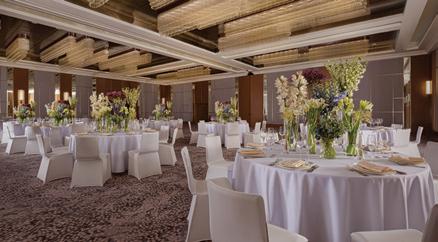 Located in the heart of Azerbaijan’s capital, The Ritz-Carlton, Baku invites guests to immerse themselves in the country’s fascinating culture.
Located in the heart of Azerbaijan’s capital, The Ritz-Carlton, Baku invites guests to immerse themselves in the country’s fascinating culture.
Please scan the QR code to access the website of the Hotel
A round-trip




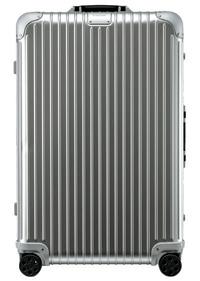



From city breaks to far-flung destinations, these are all the travel accessories you’ll need to pack



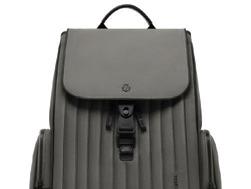




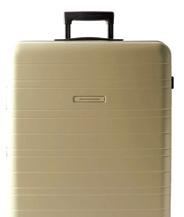







COMPILED CAMILLE MACAWILI

JULY-AUGUST 2023
1. City Trekking Leather-Trimmed Shell Backpack, Dhs6,920, Saint Laurent, ysl.com 2. Intrecciato Leather Du le Bag, Dhs19,540, Bottega Veneta, mrporter.com 3. Large Flap Backpack, Dhs5,490, Rimowa, rimowa.com
7. Pelletessuta Leggerissimo Black Cabin Luggage, Dhs6,200, Zegna, zegna.com 8. Check-In L Twist, Dhs7,390, Rimowa, rimowa.com 9. H7 Essential Hardshell Check-in Suitcase, Dhs2,010 Horizn Studios, horizn-studios.com
4. Jour O Leather Weekend Bag, Dhs13,400, Berluti, berluti.com 5. Cassette Toiletry Case in Intrecciato Leather, Dhs8,100, Bottega Veneta, ounass.ae 6. Full-Grain Leather Wash Bag, Dhs3,540, Brunello Cucinelli, shop.brunellocucinelli.com
1.
2.
4.
7.
8.
9.
5.
6.
52 LIFESTYLE
3.
COMPILED AMY
The jet set
As you hop onto an aeroplane and make the most of the holidays, here are a few smart-causal in-flight dressing essentials
+ Cubitts Cromer RoundFrame Acetate Sunglasses

Dhs580 MR P. mrporter.com
Honeycomb-Knit Cotton Zip-Up Cardigan

Dhs1,810
Sunspel sunspel.com
Printed Virgin Wool-Blend Jersey Track Jacket
Dhs2,610 Off-White off---white.com
Cotton-Blend Blazer


Dhs10,690
Brunello Cucinelli shop.brunellocucinelli.com
Tapered CashmereBlend Sweatpants


Dhs9,175
Loro Piana mrporter.com
Slim-Fit Lyocell and CottonBlend Jersey T-Shirt

Dhs900
Tom Ford tomford.com
Larry Canvas and Suede Slip-On Sneakers
Dhs860 MR P. mrporter.com

JULY-AUGUST 2023
SESSIONS
53
WORDS VARUN GODINHO
A TREAT IN THE SKY
Chandon’s Australian estate releases a vintage sparkling wine that will be exclusively available in the premium economy cabin of Emirates

With 1,400 hectares spread across six countries around the world, Chandon is believed to be the brand with the largest area dedicated to sparkling wine.

“Chandon has six wineries around the world, and we’re like the new kids on the block, given that most Moët Hennessy brands have very long histories of hundreds of years. We started our first winery in 1959 in Argentina. Since then, we’ve created five other estates spread out across Brazil and California in 1973, Australia in 1986, and then more recently over the last decade in China and India,” says Susan Caudry, Chandon Australia’s estate director. As general manager, she is responsible for the viticulture for winemaking production, supply chain and hospitality business undertaken at its Yarra Valley estate, which includes its Strathbogie and King Valley vineyards in the Victorian Mountains near Melbourne.
As Caudry explains, Chandon has become the biggest-selling sparkling wine brand in Australia in the over AU$20 –
premium segment – of the market. But while becoming a major player domestically has served it well, it has also over the last two decades exported significant quantities to more than a dozen markets in the Asia Pacific region including Japan, Thailand, Hong Kong, and Singapore, among others.
“About a decade ago, we did export a small quantity into the Dubai market while working with Maritime and Mercantile International (MMI). And then, more recently at the start of 2022, we partnered with Emirates,” says Caudry. That
partnership has seen Chandon Australia creating a vintage sparkling wine – Chandon Vintage Brut 2016 – which is not only exclusive to Emirates, but also exclusive specifically to the premium economy cabin of the carrier.
The Chandon Vintage Brut 2016 is a blend comprising 50 per cent Pinot Noir, 41 per cent Chardonnay and 9 per cent Pinot Meunier. The foremost aromas of the sparkling wine include that of lime and green apple Chardonnay, while the ones that follow are pomegranate and pink grapefruit aromas.
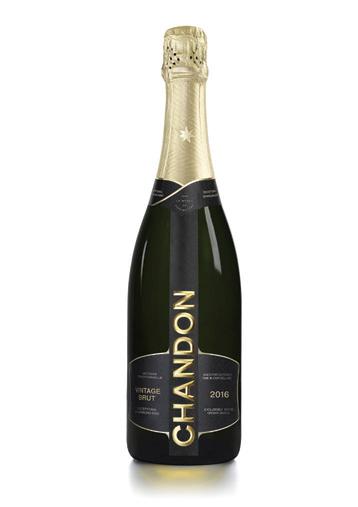
54 JULY-AUGUST 2023
On the palate, you will find lime and green apple notes, while biscuit, hazelnut praline, and fresh dough contribute extra body.
This sparkling wine is made by Méthode Traditionnelle, the same process by which champagne is made in France. At the Australian estate, the grapes are harvested in late March and pressed to a juice, after which it is mixed with cultured yeast. Chandon says that the primary fermentation takes place in stainless steel tanks, while a few select parcels are fermented in oak vessels that deliver a greater complexity.
In May, the process of assemblage occurs. That process involves blending a combination of new base wines with reserve wines that belong to previous years. After that, it’s time for the second fermentation to take place in the bottle as the ageing process commences. The wine spends a minimum of two years on yeast lees, with the lees being at least six years old.
“We have a Chandon rosé and a brut available in Dubai Duty Free. However, the Chandon Vintage Brut 2016 is exclusive to Emirates’ premium economy cabin, so you can’t access it anywhere else. Emirates
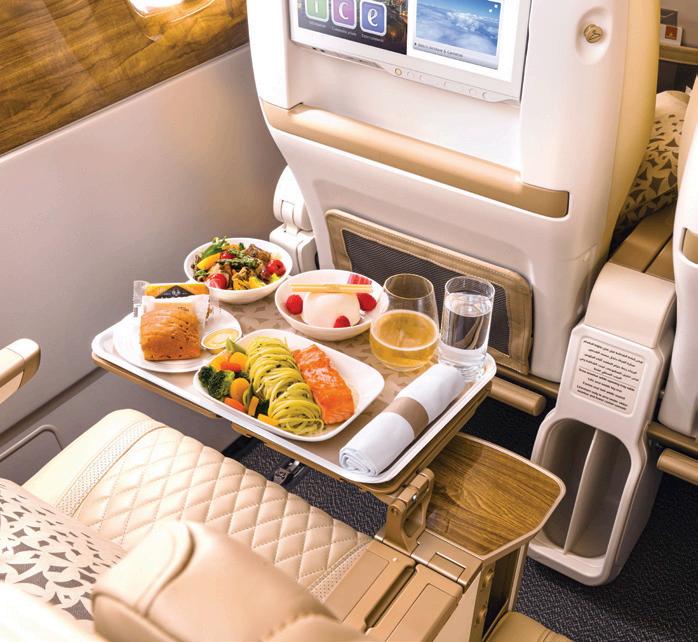
wanted to create a unique offering specific and exclusive to its premium economy,” observes Caudry.
Emirates introduced its premium economy cabin last year and rolled it out onto six aircraft initially. By the end of this summer, that cabin will be fitted on a total of 29 aircraft and will cover prime routes to London, Sydney, Melbourne, Christchurch, Auckland, New York, San Francisco, Singapore and Houston. “The premium economy is a really interesting piece of Emirates’ business model, and we’re very happy to be part of it. We’re well aligned with their values in terms of the thousand small details that make a difference to someone having an elevated luxury experience in that cabin, while our sparkling wine also has a thousand small details to get it right,” says Caudry.
Emirates takes its spirits seriously. It has reportedly spent US$1 billion on its wine programme since 2006, buying exceptional wines at the earliest opportunity and then letting them mature before serving them to their guests. The Emirates Wine Cellar is located in France and houses approximately
6.5 million bottles of fine wines. A few of these won’t be ready to be released until 2035. The airline offers around 37 different varieties of champagnes and French wines. On average, Bordeaux red wines served in its business class remain in the Emirates cellar for an average of eight-ten years, while those served in its first class do so after being aged for 12-15 years. Emirates’ vintage collection includes the likes of Château Margaux 2004, Château Montrose 2005 and Château Cos d’Estournel 2005.
Emirates also says that it purchases more champagne compared to any other airline across the world. Moët Hennessy Champagnes specifically have an over 30year partnership with the airline. At present, Emirates is the only commercial airline officially serving Veuve Clicquot, Moët & Chandon and Dom Pérignon on-board its aircraft thanks to exclusive agreements which are in effect until 2024. Dom Pérignon is served in the airline’s first class across all its global routes, while Veuve Clicquot is poured in business class on routes to the UK, the Americas, and Europe. Meanwhile, Moët & Chandon is available to business class passengers on routes to Africa, Asia Pacific and the Middle East. Economy class passengers have the option to purchase Moët & Chandon on-board their flights. Occasionally, Emirates introduces special pours for limited periods. For example, for a few weeks between September and October last year, Emirates allowed its first class passengers on select routes to enjoy a very special vintage Dom Pérignon Plénitude 2, which was an exceptionally rare 2003 vintage in its second plénitude.
The Chandon Vintage Brut 2016 is one that echoes the refined positioning that the airline is keen to highlight with its premium economy offering. “With Emirates, there’s a lot of respect for this partnership. They’re seeking to elevate their customer experience with premium economy, and they’ve chosen our vintage tier to pour on-board which says something about the higher level of an overall experience that they are striving to deliver with their product,” adds Caudry.
As to where that partnership between Chandon and Emirates can lead, Caudry speculates, “Maybe one day we’ll do an Emirates exclusive, not just something that we currently make, but something that we co-blend with Emirates and have their team involved in the making of it.”
55 CHANDON JULY-AUGUST 2023
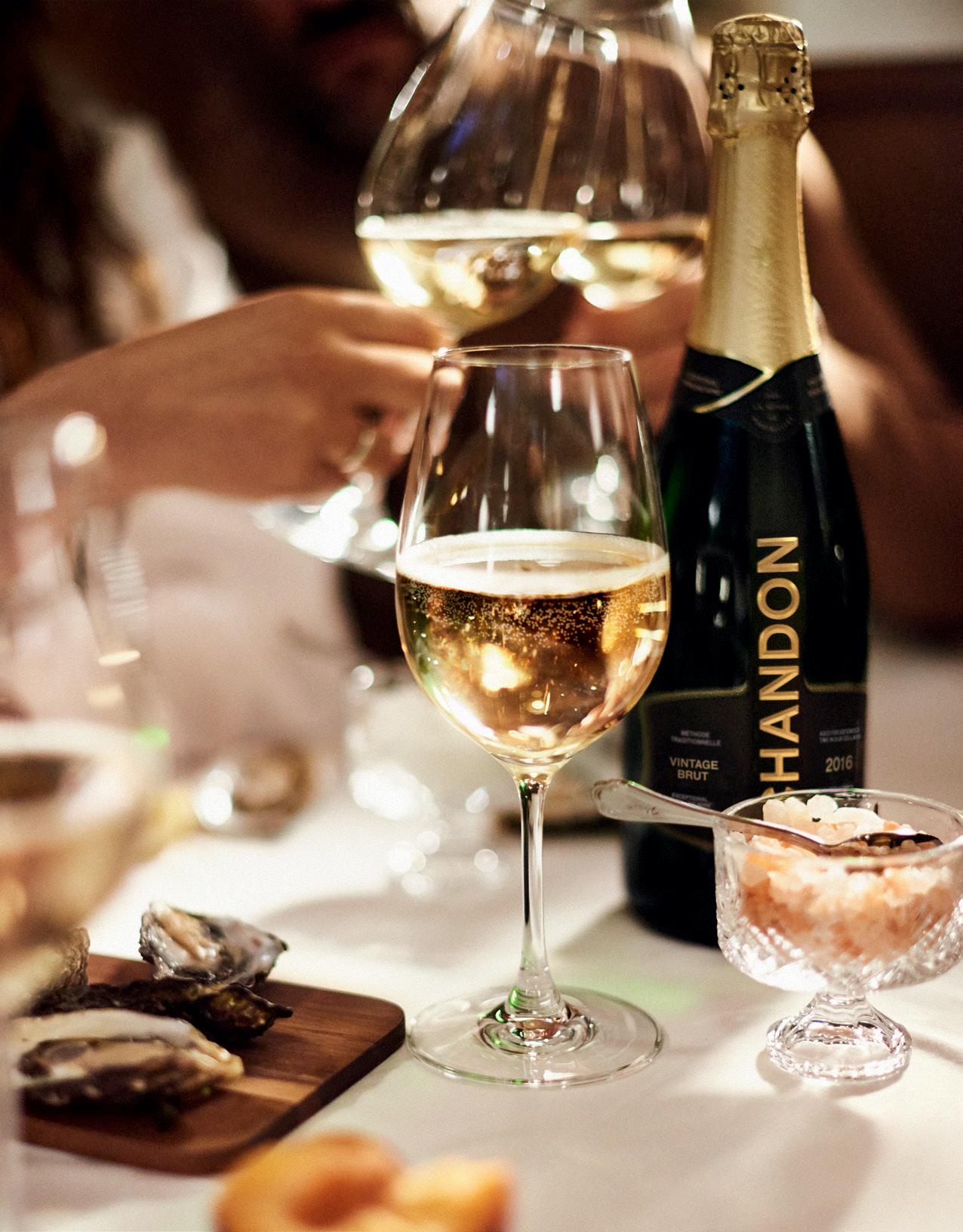





































































































































































































































































NOMINATIONS NOW OPEN FOR EVENT SPONSORSHIP AND GENERAL ENQUIRIES CONTACT manish.chopra@motivate.ae | mansi.khatwani@motivate.ae | sangeetha.js@motivate.ae #GulfBusinessAwards GulfBusiness CONNECT WITH US Presented By Vote Processing Partner Partner NOMINATE HERE
the eport Tried, Tested, Tasted. TRIED AND TESTED HOTELS Shilla Stay Gwanghwamun, Seoul Vinpearl Landmark 81 - Autograph Collection, Ho Chi Minh City Virgin Hotels New York Marriott Resort Palm Jumeirah, Dubai The Ritz-Carlton, Baku 62 63 60 61 64
Virgin Hotels New York
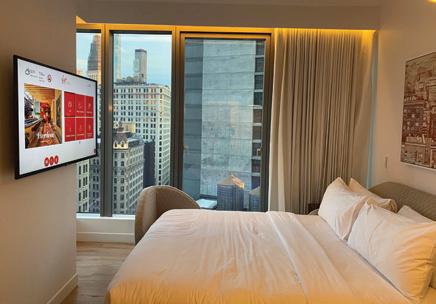

BACKGROUND Virgin Hotels New York o icially opened in April 2023. There are now a total of eight Virgin Hotels properties, all of which are located in the US except for two recent openings in Edinburgh and Glasgow.

WHERE IS IT? The property is located in the heart of Manhattan, in the city’s NoMad neighbourhood. Nearby attractions include Madison Square Gardens, Times Square and the Empire State Building.
WHAT’S IT LIKE? Full of character, with attention to detail at every turn, the design language was spearheaded by Brooklyn-based MARKZEFF and architectural firm Stance to bring out Virgin’s distinctive brand personality. This begins in the lobby, with a fun “Where’s Richard” mural by Nigel Sussman.
After the lobby you head to a bank of six “smart lifts”, though I found them to be noticeably slow.
ROOMS The hotel features 460 rooms, known as “Chambers”, including 39 suites and two penthouses. I stayed in a Chamber King, which felt spacious for a New York hotel at 25 sqm, while floor-to-ceiling windows o ered thrilling views of the city.
There are lots of distinctive and quirky details. Virgin-red accents pop up throughout, from the front door to the Smeg minibar fridge. The custom-made king-size bed has a unique concept to double up as a casual work area. This is achieved with a sofa extending
from the headboard, with builtin US power sockets and USB ports. More bizarrely is a chair back attached to the bottom corner of the bed, though I found this more of a novelty than a practical solution. Otherwise the bed was extremely comfortable, with a soft mattress, luxurious pillows and soft white cotton sheets. Opposite was a wall-mounted HD TV screen with 74 TV channels, plus Chromecast to stream your own content. The TV can also be used to order room service, adjust the air conditioning, and request a host of concierge services.
Automatic lighting is controlled by motion sensors – although this can be a bit distracting if you are a restless sleeper.
A comprehensive minibar section was packed with goodies, from Perrier Jouët Champagne to bottled cocktails. There was also a Nespresso machine with complimentary capsules and a selection of premium snacks.
A sliding door separates the bedroom from the dressing room. This is a stylish space with some nice details. An elegant dressing table features a flattering backlit mirror, and could also be used as a desk,
Virgin-red accents pop up everywhere, from the front door to minibar fridge
with power sockets and USB ports nearby. On either side are two wardrobe spaces that can be concealed with a draw curtain, and feature an iron and ironing board, umbrella and yoga mat.
A separate shower and toilet are behind frosted glass doors. The shower was large with a bench seat and rain shower option, plus Red Flower amenities in large bottles for shampoo, conditioner and shower gel.
FOOD AND DRINK Everdene is the hotel’s all-day dining space. This is an enormous 372 sqm area occupying the whole of the third floor, with multiple sections and a fantastic wraparound terrace. Its size, decor, and numerous spaces lend themselves well to all kinds of occasions, from casual meetings to cocktails and dinner. There is also live music six nights a week.
MEETINGS The hotel features 1,765 sqm of event space, including Level 38 – the Loft Event Space, and the Conservatory terrace on the third floor.
LEISURE The fifth floor gym is large with a good selection of internet-enabled Technogym equipment overlooking the Empire State Building. There is also a large outdoor terrace which is a great spot for yoga sessions.
A small pool is located on the fourth floor, which is connected to a stunning pool bar. The Exhale Spa is also due to open towards the end of the year, which will be located on the lower “Sub Cellar 2” level.
VERDICT Stylish, packed with personality and a fantastic location. Virgin Hotels New York certainly stands out and appeals to a cool, modern guest. Tamsin Cocks
JULY-AUGUST 2023
BEST FOR Stylish stays in the heart of Manhattan DON’T MISS Spectacular views from the Everdene terrace PRICE Internet rates for a flexible midweek stay in July start from US$300 for a Chamber King room CONTACT 1227 Broadway, New York, NY 10001; +1 844 556 7597; virginhotels.com/nyc
A signature Italian restaurant will also open this summer on the fourth floor.
& TESTED HOTEL 60
MICHAEL MUNDY 2023
TRIED
Marriott Resort Palm Jumeirah, Dubai
BACKGROUND When it opened last December, it became Marriott’s first resort in the UAE. It also marked its 50th property in Dubai alone. In many ways, a debut resort o ering demonstrates a desire by Marriott to increasingly speak to the ‘bleisure’ segment of travellers.
WHERE IS IT? Located at Palm West Beach, it’s got the location spot-on for a resort. Nearby, are several other resorts from the likes of Hilton, FIVE and Radisson. With private beach access and prime views of Dubai Marina and Ain Dubai, this is a great location for Marriott.

WHAT’S IT LIKE? There’s an expansive lobby welcome area with reception desks to the left and elevators to take you to your room on the right. Walk straight after entering the doors of the lobby, and it will lead you to a lounge café where you would do well to ask for its signature o ering of chocolate ravioli.
ROOMS We stayed in the M Club Room King which was interconnected to another M Club Room with double beds. Both rooms were large and the décor was classy with a beige and brown colour scheme, wooden flooring, a work desk with long mirrors above it and a leather-clad swivel chair next to it, as well as a sofa, and a large-screen TV. There was also recessed
BEST FOR
A weekend resort getaway that’s still very much in the city
DON’T MISS
A meal at Cucina, and the 25-year-aged balsamic vinegar
PRICE
Internet rates for a midweek stay in July start from Dhs900 for an M Club Room King

CONTACT
Palm Jumeirah, Palm West Beach, Dubai; +971 4 666 1111; marriott.com
lighting in the room which kept the levels of ambient light comfortable in the evenings. USB cable points were located near the bed and multiple plug point types were installed near the desk. There was an extensive pillow menu (options include buckwheat, and memory foam, among others), a Nespresso machine, plenty of wardrobe space and a large bathroom with a separate shower cubicle as well as a tub. The 602key property also has 46 suites including two presidential suites and two penthouses
FOOD AND DRINK There were eight F&B concepts when we visited. Señor Pico is a Californian-Mexican beachfront restaurant with a very reasonably priced menu and whose hits include beef chorizo nachos and churros. Another highlight here is the Italian restaurant, Cucina. Apart from a large communal area, there is also a private dining space with an indoor vertical farm adjacent to it. Our dinner at Cucina was accompanied by a lively DJ set. While
we waited for our mains, we happily tucked into the heirloom tomatoes accompanied by balsamic vinegar aged for 25 years. All of the restaurant’s pasta, ravioli and ice creams are hand-made in-house. While Myami Pool Bar and Lounge has great options of soft shell crab sliders, lobster rolls and wagyu burgers, a hearty breakfast bu et spread can be found daily at Levantera.
MEETINGS There are eight meeting rooms as well as one grand ballroom. There is also a majlis indoor space for smaller events. That majlis area has access to a 1,000 sqm outdoor terrace space with sea views. Up on the 14th floor of the property is M Club. Apart from a small meeting room, the club can also be used to meet with your guests in a space which is a little more private than the lobby downstairs.
LEISURE There’s a 75-metre pool with four spa baths along the edges of it. The main pool has a swim-up bar, while a separate kid’s pool is located next to the kid’s club. In the cooler months, you can
Marriott’s rst resort in the UAE also marks its 50th property in Dubai
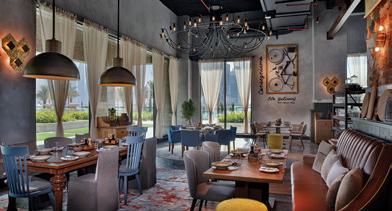
head to the stretch of private beach right in front of the resort. The well-equipped fitness centre is open 24 hours and the Saray spa features private treatment rooms including a couples’ suite with a waterbed and spa bath too.
VERDICT As Marriott’s first resort in the UAE, it has presented a great property with plenty of leisure amenities, good restaurants, and also a great mix of indoor and outdoor events and meeting spaces. It’s a solid template, which begs the question: are we about to see a number of more Marriott resorts open in the region over the coming years? Varun Godinho
JULY-AUGUST 2023
TRIED & TESTED HOTEL 61
Shilla Stay Gwanghwamun, Seoul
BACKGROUND Shilla Stay is an upscale business hotel brand from The Shilla Hotels and Resorts, a Korean group (named after the ancient Shilla Dynasty) which is a subsidiary of Samsung and member of Leading Hotels of the World.

The Shilla Hotels and Resorts operates two premium hotels in Seoul and Jeju under The Shilla brand, while its Shilla Stay brand launched in 2013 to attract business guests. There are now 12 properties under the brand, with the Gwanghwamun outpost (named after the nearby gate of the Gyeongbokgung Palace) open since 2015.

WHERE IS IT? Found in Seoul’s downtown Jongno-gu district, it is surrounded by attractions such as the Gyeongbokgung Palace, the South Korean president’s former residence, and Buddhist temple Jogyesa. It is also close to financial, media and government buildings, and a short walk from subway stations Jonggak (Line 1) and Gwanghwamun (Line 5).
WHAT’S IT LIKE? The unassuming 19-floor building fits into the high-rise surroundings. A sleek and darkly decorated hallway leads to a bank of lifts for the eighthfloor lobby – floors 2-7 are reserved for o ices.
The open-plan lobby features smart and minimalist interiors by Italian designer Piero Lissoni, characterised by clean lines and dark furnishings while exposed filament
lighting and a modern fireplace brighten up the space.
The hotel’s facilities are all located on the eighth floor, with a small reception desk, a café/restaurant and a stylish lounge area as well as a communal co-working table that is popular with digital nomads. Check in takes place after 3pm, with check out by noon (with an express option to drop o your keys if you have pre-paid).
ROOMS The 338 rooms are located on floors 9-19, with keycard access required in the lift, and come in four categories (standard, deluxe, premier deluxe and grand). The first three measure 24 sqm, with the latter at just under 48 sqm.
My premier deluxe room on the 18th floor was small but had everything I needed for a short stay. It is well-designed for work, with a built-in wardrobe as you enter and then a

toiletries, along with an excellent rain shower. A sliding door from the main space hides the glass wall to the bathroom, which is an interesting albeit unnecessary touch.
The downside is that the room gets very hot and you can’t control the air conditioning – the receptionist told me that the hotel had central heating and I could open the window to cool the room, but the streets below are noisy at night.
FOOD AND DRINK The hotel has a large restaurant on the eighth floor which o ers a bu et for breakfast (6.30-9.30am on weekdays, 7-10am on weekends) and lunch (11.30am-2pm; 12-2.30pm). Breakfast comes at an additional £14. The adjoining bar is open every evening from 6-11pm.
MEETINGS Four meeting rooms range from 23 sqm to 85 sqm on the eighth floor.
LEISURE There is a fitness centre on the eighth floor.
window-facing desk, sofa (in premier deluxe and above) and double bed in the main space. While I didn’t spend much time in the room, it was well-suited for the moments when I needed to work or sleep – the blackout curtains and comfy bed helped ease my jet lag symptoms. High-speed wifi is o ered throughout the property, and there are well-located UK and European plug sockets in the room.
Amenities include a 40-inch LED TV, a minibar (though no contents), complimentary co ee and tea bags, two complimentary bottles of water per night, a safe, iron and ironing board, and two bathrobes and slippers. The bathrooms include a Toto toilet, large refillable bottles of beautifully scented
VERDICT An ideal and well-located stay in Seoul, with all the necessary amenities required for work needs. Hannah Brandler
BEST FOR
Business travellers in need of a comfortable stay and workspace
DON’T MISS
Exploring the local historic attractions and stylish cafés PRICE
Internet rates for a flexible midweek stay in July start from KRW154,000 for a Premier Deluxe room
71 Sambong-ro, Jongno-gu, Seoul; +82 2 6060 9000; shillastay.com/gwanghwamun
JULY-AUGUST 2023
The downside is the room gets very hot and you can’t control the air conditioning
CONTACT
62
TRIED & TESTED HOTEL
Vinpearl Landmark 81 - Autograph Collection, Ho Chi Minh City
beige and gold fill the bedroom while floorto-ceiling windows line its walls (all 223 rooms and suites feature similar windows). My room had a comfortable lounge chair with an ottoman that served as the perfect spot for me to watch the city come to life in the morning along with my co ee. There was also a large desk with ample charging ports, while USB ports and a control panel for the air conditioning and lighting were all located bedside. The bathroom featured a bathtub and a separate shower area with amenities which were completely locally made, from the bottle itself to the product inside of it.
BEST FOR
The in-house pho and the lavish breakfast spread
DON’T MISS
A dip in its outdoor infinity pool
PRICE
Internet rates for a midweek stay in July start from VND6,370,000 (US$270) with breakfast

CONTACT
720A Dien Bien Phu Street, Binh Thanh District, Ho Chi Minh City; +84 28 3971 8888; marriott.com

BACKGROUND Situated in Landmark
81, Vietnam’s tallest building, Vinpearl Landmark 81 - Autograph Collection by Marriott opened earlier this year in the country’s financial hub of Ho Chi Minh City.

WHERE IS IT? Landmark 81 is located on the west bank of the Saigon River in the city’s Binh Thanh District. It can be easily spotted and is a short distance from the major landmarks including the Independence Palace and the Opera House. The hotel is nestled between the 47th-71st floors of the building whose tip is 470m o the ground.
WHAT’S IT LIKE? The hotel emanates a refreshing design that blends bold lines, warm tones and plenty of natural light across its spaces. Its lobby on the 48th floor opens up to an expansive space with marble floors and a grandiose chandelier in the reception area. You can take in breathtaking views of Ho Chi Minh City while you check in.
ROOMS We were given a club room on the 60th floor. Club rooms have access to the city’s highest Club Lounge on the 71st floor which is open all-day and o ers a lavish breakfast spread and evening cocktails. Upon entering the Club Room Panoramic View, I was awed by the rich design language that flows through it. Tones of
FOOD AND DRINK There are two restaurants in the hotel. Oriental Pearl is its all-day dining restaurant on the 66th floor and features Vietnamese and international cuisine as well as themed bu ets. The lobby lounge restaurant, The Cloud, meanwhile has an impressive range of Vietnamese
co ee (indigenous co ee with condensed milk). We quite enjoyed a lunch here which consisted of spaghetti arrabbiata and bánh mì (Vietnamese bread) with meat. Dinner was at Oriental Pearl where the chef prepared a special chicken pho upon request (the Vietnamese noodle soup is usually made with beef). There are simple flavours in this wholesome soup which were accentuated with lemon, herbs and spices. There is an extensive breakfast spread, but I stuck to eggs with a side of cheese and ham along with some Vietnamese co ee.
The hotel is nestled between the 47th-71st oors of Vietnam’s tallest building
BUSINESS For those travelling to Vietnam’s financial capital for business, there are great meeting facilities within the hotel. It has one ballroom, ten meeting rooms and three terraces on the 48th, 66th and 69th floors respectively. The Grand Ballroom is Ho Chi Minh City’s largest hotel ballroom and can house up to 1,500 guests. In addition, on the 69th floor, the Sky Studios is an exclusive collection of three smaller meeting rooms and has a sky terrace too.
LEISURE The hotel’s outdoor infinity pool is located on the 47th floor. It’s an ideal spot to watch the sun set over the city’s skyline. The same floor houses the Akoya Spa with ten treatment rooms, alongside steam and sauna facilities.
VERDICT It’s Vietnam’s latest landmark hotel destination with contemporary o erings that appeal to both leisure and business travellers. Akanksha Maker

JULY-AUGUST 2023
TRIED & TESTED HOTEL 63
FOOD AND DRINK
The Ritz-Carlton, Baku
BACKGROUND The Ritz-Carlton, Baku opened in December last year in Azerbaijan’s capital. Baku, famous for its rise to prosperity since the oil boom, has become a major destination for GCC business and leisure travellers (you can read more about the city on pg46). Once a key stop on the Silk Road, it is easy to feel a sense of deep history right across this country.
WHERE IS IT? Located in the city’s business hub, close to the Baku Convention Center and Heydar Aliyev Center which hosts several major events, this hotel is also only a 15-minute drive from the airport and the Old City.

WHAT’S IT LIKE? The property is a beautifully designed piece of modern architecture. One of several modern glass structures within Baku, the interiors here are a mix of subtle tones and grand chandeliers, glass and light. High ceilings make the hotel feel extremely spacious and it comes across as a feat of modern elegance.
ROOMS The hotel has 190 rooms and suites. I stayed in the Grand Deluxe Queen Twin room. My room felt as big as many suites and featured an enormous marbleclad bathroom with both a shower and tub. The room had a large seating area and work desk space. A highlight was the uninterrupted views, from the floorto-ceiling windows, of the Heydar Aliyev
Center which is a Zaha Hadid-designed architectural triumph. There was also plenty of hanging space and available floor area to open suitcases. It can comfortably host two people, a bugbear in many hotels with smaller rooms.
The room felt as big as a suite and featured an enormous marble-clad bathroom
BEST FOR Leisure facilities, including the spa and indoor pools
DON’T MISS
Breakfast is a feast for the senses with global and local delicacies
PRICE
Internet rates for a midweek stay in July start from AZN675 for the Grand Deluxe Queen Twin room without breakfast

CONTACT
3 Babek Avenue, Nasimi District, Baku; +994 12 460 7777; ritzcarlton.com

The hotel has two outlets. Its all-day dining concept, Tribeca, is a New York-style diner and bar, while the prohibitionstyled Blind Tiger bar is buzzing in the evenings. Breakfast at Tribeca is a feast. From fresh salads to the egg station, and international cuisine to local fare such as Azerbaijan’s shakshuka, there are plenty of choices. The dining area is vast, but is divided into sections and also has a spectacular outdoor terrace. For lunch and dinner, the restaurant boasts a California-inspired menu with everything from light bites to meat specialities.
BUSINESS With more than 2,200 sqm of meeting spaces, The Ritz-Carlton, Baku is well-positioned to host corporate gatherings and celebrations. From the 10-person meeting facility within an executive boardroom to the ballroom which can accommodate up to 280 people, each space is kitted with modern technology and floor-to-ceiling windows which fill it with natural light.
LEISURE The hotel has a huge gym, making sticking to your fitness regime much easier, especially in the face of Baku’s incredible cuisine. Fitted with Technogym equipment, it is bright and overlooks the Heydar Aliyev Centre. The spa and indoor pools meanwhile were not open while I was there, but there are still more facilities to open as the hotel progresses through its early months.
VERDICT This is a great business hotel with all the facilities needed to make life easy on a work trip. There is free private parking and a garden to enjoy the good weather too. Melanie Swan
JULY-AUGUST 2023
TRIED & TESTED HOTEL 64
Revolutionary, new out-of-home (OOH) advertising medium, powered by innovative technology.




This unique and globally patented Escalator Step Branding Solution that gives brands an unrivaled opportunity to connect with audiences.













CONTACT US TODAY fatima.alkhalidi@motivate.ae +971 4 427 3000
Dreams take flight
Space flight company, Zephalto, has opened bookings for those who wish to experience a round trip 25km above the Earth’s surface in a pressurised capsule, lifted by a stratospheric balloon. The luxurious Joseph Dirand-designed Céleste capsule will depart from France starting late 2024 with up to six guests on each flight, in addition to two pilots. Each six-hour round trip will involve spending up to three hours at the balloon’s maximum altitude which is 15km higher than the height at which airlines fly. From there, guests will be able to view the Earth’s spherical curve. The 20 sqm capsule will be divided into three cabins and guests will reportedly be able to enjoy a ‘Michelin-star dining’ concept too. Sign us up.
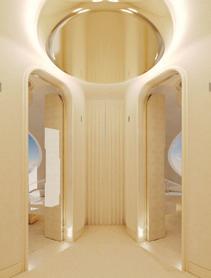



JULY-AUGUST 2023
66 POSTCARD
Grow with
Welcome to the Exceptional Radisson Collection is a new generation of iconic properties and one-of-a-kind spaces. In our collection of exceptional hotels, no two are ever the same and each has a unique character authentic to its locality.

Be Bold. Be Creative. Be Original Located in cosmopolitan centres across Europe, art’otel is a contemporary collection of lifestyle hotels that merge a unique architectural style with art-inspired decor.


Creating owner value through everything we do across our range of global hotel brands
emeadevelopment@radissonhotels.com Enjoy it! Radisson RED is a nimble & bold lifestyle brand with a lean operating model at vibrant destinations. RED delivers a stand-out experience. Welcoming and fashionable hotels in the beating heart of buzzing destinations.
us
radissonhotels.com/development
CONNECT TO AMAZING FLAVOR
with delicious choices

Products and services are subject to change depending on flight duration and aircraft.

































































































































































































































































































































































 Adnan Kazim , chief commercial officer for Emirates Airline, is overseeing one of the most remarkable and profitable periods in the carrier’s history. Here’s how he plans to keep up the momentum
Adnan Kazim , chief commercial officer for Emirates Airline, is overseeing one of the most remarkable and profitable periods in the carrier’s history. Here’s how he plans to keep up the momentum






























































































































































































































































































































































 BOTTOM: You can adjust the temperature in Lufthansa’s Allegris cabins; Humidity percentages onboard
BOTTOM: You can adjust the temperature in Lufthansa’s Allegris cabins; Humidity percentages onboard








































































































 FROM TOP: The Ritz-Carlton, Baku; Manzara Sky
FROM TOP: The Ritz-Carlton, Baku; Manzara Sky




 Located in the heart of Azerbaijan’s capital, The Ritz-Carlton, Baku invites guests to immerse themselves in the country’s fascinating culture.
Located in the heart of Azerbaijan’s capital, The Ritz-Carlton, Baku invites guests to immerse themselves in the country’s fascinating culture.































































































































































































































































































































